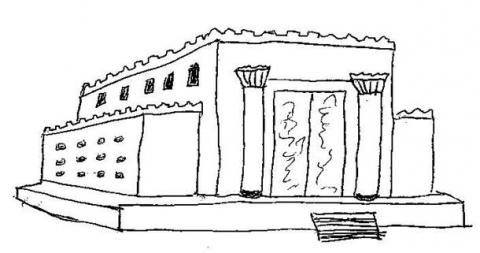High School Overview (Schedule, Recipes, etc..)
OLD TESTAMENT
HIGH SCHOOL
This file is provided as a resource for Church School directors. Feel free to plug in your own dates and your own teachers.
Teachers:
Schedule of Classes:
|
Date |
Teacher |
Lesson/Activity |
Special Notes |
|
September 13 20 27 |
|
Creation Adam & Eve/The Fall Noah |
|
|
October 3 4 11 17 18 25 |
|
Movie Night: Noah Tower of Babel Abraham Movie Night: Abraham Isaac Jacob |
Outdoors if possible
Social Hall after Vespers
|
|
November 1 8 15 21 22 29 |
|
Joseph #1 Joseph #2 Moses #1 Movie Night: Moses Moses #2 Balaam |
All Saint’s Party
Social Hall after Vespers Memory: 10 Commandments |
|
December 5 6 13 20 27 |
|
St. Nicholas Party Joshua Judges/Gideon Nativity Pageant Job |
Parish Wide
Social Hall and Nsg. Home
|
|
January 3 10 17 24 30 31 |
|
Ruth Samuel/Hannah Saul David/Goliath/Psalms Movie Night: David David |
3 Kings Party following
Memory work: Psalm 22 Social Hall after Vespers
|
|
February 7 14 21 27 28 |
|
Solomon Proverbs/Song of Songs Elijah Movie Night: Elijah Elisha |
Pack School Kits
Social Hall after Vespers |
|
March 7 14 21 28 |
|
Jonah Isaiah Jeremiah Ezekiel |
|
|
April 4 5 11 18 25 |
|
PASCHA Bright Monday Egg Hunt 3 Young Men in Fire Tobit Daniel |
No Class After Liturgy
Pack Health Kits
|
|
May 1 2 9 16 23 30 |
|
Movie Night: Esther Esther Minor Prophets No lesson: Camping Trip Minor Prophets Ezra/Nehemiah |
Social Hall after Vespers
Memory Work: Books of O.T.
Book Collection |
|
June 6 12 13 |
|
Maccabees Dress Rehearsal Closing exercises/play |
Book Collection Social Hall after Vespers Social Hall and Nursing Home |
Classroom supplies: The teen class has a box with each of the students’ Bibles, pencils, paper, sharpener, etc. Note that if you are using the Orthodox Study Bible, the Scripture references are different from those of the Protestant or Roman Catholic Bible. References in the curriculum are listed with both the Orthodox Study Bible books (from the Septuagint) and the Protestant Bible books. These will only affect the books of I and II Samuel, now called I and II Kingdoms, and I and II Kings, now called 3 and 4 Kingdoms.There is also a huge pad of paper with magic markers to use in the place of a chalkboard. There is also a Bible atlas for reference as well as a timeline of Bible times and also placing them in the context of world history.
Teaching Schedule: We all know that there will be last-minute needs; trade with someone if you cannot teach on your assigned day and let the director know!
Paperwork: Each of us must “apply” each year for our volunteer position of teacher. There’ll be a form to fill out at the annual parish meeting for new teachers or just to sign for returning ones.
Opening Exercises: Teens do not need to attend opening exercises. They should go to their class space with their teacher after a brief snack in the Social Hall.
Curriculum: Each lesson will have the relevant Scripture passages for factual content (hopefully review of already known material) with a suggestion for how to attack the material. While it would be wonderful to expect the teens to have read the material ahead of time, it doesn’t happen. On the other hand, reading aloud in class is “boring”-- hence the somewhat devious methods of attacking the material to force a careful reading in the opening minutes of class without putting anyone to sleep. References to services will be included, not just where the passage is read (There are too many of these to enumerate, and what’s the point, you can read the calendar.) but where it is drawn on in the songs or symbolism of the Church. While this may seem long and arduous, I have actually typed the entire reference rather than having the class look it up in the service books, which would be even more long and arduous. And, finally, some discussion material to bring the rather ancient, dusty characters into modern life. As you all know, with teens this can be dicey. One week they’ll discuss their hearts out and the next you’ll have a class full of sleeping logs. So use what works and ignore the rest!
Movie Nights and Parties: We will have pizza after vespers on Saturday night while showing a small children’s movie. Older children and teens should bring a sleeping bag for a lock-in with “feature” presentation; we must have at least 2 adults at each overnight.
Icons: Each lesson is now illustrated with an icon, gleaned from non-copyrighted websites on the Internet. Feel free to enlarge these and use to amplify your lesson.
Creation
CREATION
Possible Lesson Plan:
- Open with prayer.
- Scripture reading: Genesis 1 & 2. One way to help the students meet the factual objective for this lesson would be to have a large list of things on the board. As they read, have them categorize the things according to the day they were created. Alternately, have the teens compare and contrast the two creation stories (Genesis 1 and Genesis 2). Why are there 2 stories? How do the two different accounts enhance our understanding of Creation?
- Service references: On Christmas, the Nativity, Genesis 1:1-13 is read, as the hymns sing, “Every creature made by Thee offers Thee thanks. The angels offer Thee a hymn; the heavens a star; the Magi, gifts; the shepherds, their wonder; the earth, its cave; the wilderness, the manger…” But, the cross is also prefigured by the tree of life in the vespers of the Feast of the Elevation of the Holy Cross: “The Tree of true life was planted in the place of the skull…” Canticle three of the Canon sung on Holy Saturday matins beautifully portrays the groaning of creation, “When the creation saw Thee hanging in Golgotha, who hast hung the whole earth freely upon the waters, it was seized with amazement and it cried: ‘There is none holy save Thee, O Lord.’ And again, “Today a tomb holds Him who holds the creation in the hollow of His hand; a stone covers Him who covered the heavens with glory…” But Creation is not lost, the Resurrection is prefigured by the Sabbath on which God rested, “For this is the blessed Sabbath, this is the day of rest, on which the only-begotten Son of God rested from all His works…He kept the Sabbath in the flesh; and returning once again to what He was, through His resurrection He has granted us eternal life…”
- Discussion and application:
Where did God come from? What’s the difference between Creator and created? Many Eastern religions have elevated all things to an undifferentiated oneness – leading to the pantheistic view that all is one and all is divine and therefore all is valuable. How is this different from the Judeo-Christian perspective? (that God created everything and therefore everything has value)
What puzzles you about Creation? We’ll discuss evolution more fully under Noah, but Creation is an unpopular belief in today’s world, while it was the dominant belief 100 years ago. How can you explain the six days? What about the order of creation? Does it “make sense”? Does 60 million years make any more sense?
What about our relationship with the environment? This is the first lesson of the new liturgical year; the first day of the new year, September 1, is designated as environmental awareness day. What environmental issues are discussed in school? (water pollution, endangered species, acid rain, global warming, air pollution, rain forests; let the students brainstorm) How is man different from the rest of Creation according to Genesis? (He was created in the image of God.) Does this give us special responsibility? What attitude do many people have today toward God’s Creation? How does this differ from the ideal? Do we have a good “record” in our care for the earth? What would be an appropriate response to having “dominion” over the rest of Creation? How have you personally treated God’s Creation? What can you personally do to change your relationship to God’s Creation?
- Close with prayer: Have each student choose a particular part of the created world they appreciate to thank God for and a particular action they will change to benefit the rest of Creation.
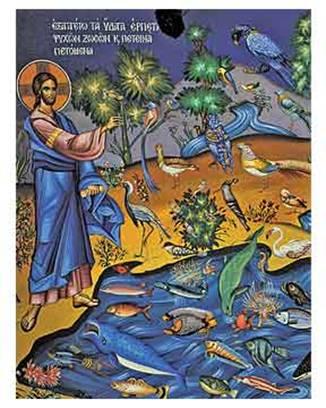
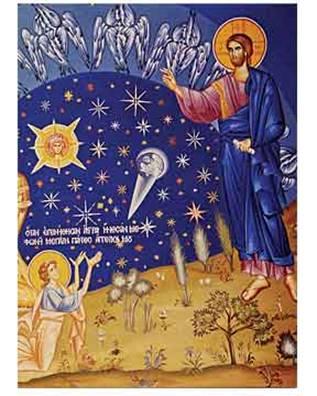
Adam and Eve and the Fall
ADAM AND EVE
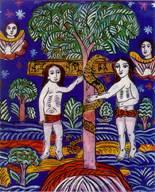
Possible Lesson Plan:
- Open with prayer.
- Scripture reference: Genesis 3. Pose the question before they start to read: Which character – Adam, Eve, or the Serpent -- was least responsible for causing sin to enter God’s creation? After the students read the passage, assign a corner of the room to each character and have the students each stand in the corner that best represents their answer to the question. Have each corner group come up with 2 reasons why their character is not to blame. Debate the issue. Do we also tend to blame others for our failings?
- Service references: Mary is called “the restoration of Adam and the recalling of Eve” in the vespers of the feast of her Nativity, as Romanos the Melodist proclaims, “O Undefiled, by thy holy Nativity Joachim and Ann were set free from the reproach of childlessness, and Adam and Eve from the corruption of death.” At the matins of her Annunciation, Mary prays, “May the condemnation of Eve be now brought to naught through me; and through me may her debt be repaid this day.” But, she wonders if the angel might be Eve’s serpent, “I fear lest thou deceive me, as Eve was deceived, and lead me far from God.” How is Mary the restoration of Eve?
But, with the birth of Jesus, Germanos proclaims at vespers, “The middle wall of partition has been destroyed; the flaming sword turns back, the cherubim withdraw from the tree of life, and I partake of the delight of Paradise from which I was cast out through disobedience.” And John the Monk proclaims, “Today the ancient bond of the condemnation of Adam is loosed. Paradise is opened to us: the serpent is laid low. Of old he deceived the woman in Paradise, but now he sees a woman become Mother of the Creator…The sinful vessel that brought death upon all flesh has through the Theotokos become the first fruits of salvation for the whole world.” This salvation continues in the matins of the feast of Theophany, “Jesus, the Prince of Life, has come to set loose from condemnation Adam the first-formed man; and though as God He needs no cleansing, yet for the sake of fallen man He is cleansed in the Jordan.” How is the sin of Adam and Eve countered at Christmas and Theophany?
But, of course, with the crucifixion, “a tree put forth the fruit of death in Paradise; but life is the flower of this Tree on which the sinless Lord was nailed.” The thief becomes Adam in “Verily the enemy did expel Adam from paradise because he ate of the fruit. But Christ, by his Cross, admitted the thief in his place, when the latter cried, Remember me, O Lord, when thou comest into thy kingdom.” And again with the Passion Gospels, “Through a tree Adam lost his home in paradise, but through the tree of the cross the thief came there to dwell. By tasting of the fruit, the first broke the Creator’s commandment, but He who was crucified with Thee confessed Thee, the hidden God.” We are refreshed by the water of the crucifixion, “O thou who didst take from Adam a rib and therewith make Eve, thy side was pierced with a spear, and from it sprang forth the fountain of purification” on Great and Holy Saturday, and in the Passion Gospels, “From Thy life-bearing side, O Christ, a fountain flows forth as from Eden, giving drink to Thy Church as to a living paradise. From there it divided to become the four rivers of the Gospels, watering the world, gladdening creation, and teaching the nations to worship Thy kingdom in faith.” Jesus raises Adam on Holy Saturday, “Adam was afraid when God walked in Paradise, but now he rejoices when God descends to hell. Then he fell, but now he is raised up.” The icon of the Resurrection shows Jesus raising Adam and Eve on His right and left. Jesus is the new Adam, “The second Adam, He who dwells on high, has come down to the first Adam in the depths of hell.” How is Jesus the second Adam? But we are warned on Cheesefare Sunday, “Verily, Adam by disobedience was exiled from paradise and driven from bliss, having been deceived by the words of the woman; and he sat opposite Eden naked and wailing. Let us all, therefore, be careful how we receive the season of fasting, obeying the traditions of the Gospels, that, becoming thereby acceptable to Christ, we may once more attain to paradise.”
- Discussion:
Why does God allow people to sin? To make their own decisions? Do we
have free will or are we “predestined” to sin? Did Adam and Eve actually have a choice?
Who is Satan? What happened to Lucifer, the greatest of all the angels? (He was thrown out of heaven because he tried to be as great as God.) Why doesn’t God kill Satan?
In the Canon of St. Andrew of Crete, which we recite during the first week of Great Lent, St. Andrew laments: “For failing to observe just one of Your commandments, O Savior, Adam was justly exiled from Eden. What then shall I suffer for continually ignoring Your words of life?” What temptations do you face in your life? Brainstorm, and make a list. Read I Corinthians 10:13. We all face the same temptations, under various cultural disguises. How can you “stand up” under each of these temptations? List a solution for each problem. How could Adam and Eve have dealt with their situation? Try re-writing the story with a different ending.
What was the outcome of the story? What happened to Adam and Eve? What is the outcome when we sin? If we “get caught”? If we don’t “get caught”?
When people sin, they often blame others. Break into 3 groups of “lawyers” (Satan’s, Adam’s, Eve’s) and think of 3 reasons why the other 2 characters would be more to blame than your own “client”. Then hold a debate – did anyone win?
- Close with prayer: Have each student pray for a solution to two temptations that are facing him here and now. Have students agree to pray for each other this week to help them overcome these temptations.
Noah
NOAH
Possible Lesson Plan:
- Open with prayer.
- Scripture reference: Genesis 6-8. Long reading of a story very familiar to most of the students. See if they can write the salient features in 10 sentences or fewer as if they were writing a story or skit for smaller children.
- Service references: The Church uses Noah as a prefigurement of Theophany. In the blessing of the waters, “Thou art our God, who has drowned sin through water in the days of Noah,” and again in matins, “We know that in the beginning Thou hast brought upon the world the all-ruining flood, Unto the lamentable destruction of all things, O God who revealest wonders most great and strange: And now, O Christ, Thou has drowned sin in the waters unto the comfort and salvation of mortal men.”
In the Canon of St. Andrew of Crete, sung during the first week of Great Lent, we can lament with St. Andrew: “I have imitated those who in the days of Noah indulged themselves, and like them I deserve to perish in a flood. Noah's son Ham failed to conceal his father's nakedness, and even dared to look at him in his shame. And you, my soul, in your treatment of your neighbour have imitated him.”
- Discussion:
What puzzles you about the Flood? About Creation? How can we reconcile the Biblical account of Creation and the Flood with the theory of evolution taught as fact in many of our schools? Darwin’s initial theory involves the limited and observable movement within a species to better adapt to its environment. But many people have enlarged that theory to include all of creation and history. Discuss the theory of evolution and the Biblical story of Creation and the Flood. Is one more plausible than the other? Is there evidence to “prove” evolution or is it a theory? List several pieces of “evidence” given to prove evolution: (fossils, carbon 14 dating, basic cell structural similarities; let the students brainstorm) Now see if they can explain these same things using Creation and the Flood. (Whole beds of animals and plants were buried in mud in the Flood…Carbon 14 dating assumes a continuity of solar radiation, not the vast difference before and after the waters in the heavens fell to earth…If God made a good thing, why change it for every species?) So… Why has the scientific world (with few exceptions) accepted evolution as fact and “creationists” as religious crackpots? Do people tend to interpret information through the filter of their own beliefs? Everyone agrees that Christians have a “bias” towards Creation; but do non-believers also have a bias that blinds them to instances that do not “fit” the theory of evolution? What would have to happen for algae to become a person? Let students brainstorm a moment. Does it seem likely? Is there any evidence, let alone proof, that this could happen?
Is the point of the story of Noah to argue the case of Creationism? It’s easy to get caught up in winning an argument or proving a case. But, what is the true “point” of Noah? Brainstorm a bit. Obedience to God even though the requested service is “silly”? Think about how Noah must have felt, building that ark in his yard with all the neighbors laughing their heads off. Have you ever had to do something “silly” to serve the Lord? Something other teens will laugh at? How did Noah respond? How do we respond? Is this “peer pressure”?
- Close with prayer: Have each teen consider some situation where he or she was afraid to look silly and bowed to peer pressure and pray for courage to obey God the next time.
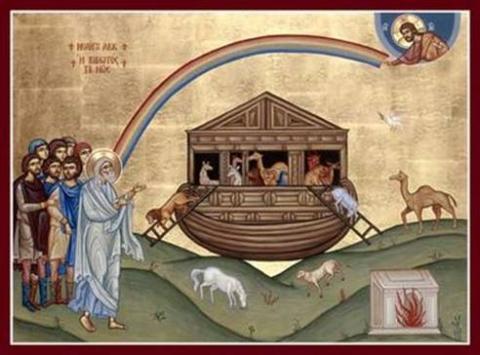
T
Tower of Babel
THE TOWER OF BABEL
Possible Lesson Plan:
- Open with prayer.
- Scripture Reference: Genesis 11:1-8. Such a short lesson, it may be easiest to just read it aloud, each student taking a verse in turn around the circle. Why did the people build the tower? Why did God confuse their languages?
- Service References: St. Andrew of Crete, in his canon sung the first week of Great Lent, laments: “You, my soul, desire to build a tower as a fortress for your lusts, as the people of Babel erected a tower to increase their strength. But as He did with them, so will the Creator also overthrow your desires and shatter all your plans.”
It comes as no huge surprise that the confusion of the languages at the tower of Babel is compared by the Church with the speaking in tongues of Pentecost. “Of old there was confusion of tongues because of the boldness of the tower-builders. But those tongues have not uttered wisdom for the glory of divine knowledge. There God condemned the infidels to punishment, and here with the Spirit Christ illuminated the fisherman. At that time the confusion of tongues was designed for vengeance, but now the unison of tongues hath been renewed for the salvation of our souls.” The practice of “speaking in tongues” is discussed by Paul as a “gift of the Spirit” and is still practiced today. In some Pentecostal denominations, the ability to speak in tongues is considered proof of the indwelling of the Holy Spirit. What does the Orthodox Church teach about this “gift”?
- Discussion:
If you’re an actor (or actress) or can recruit one, this would be the perfect
time for a cross-cultural experience. Suddenly start talking another language (or nonsense syllables, they won’t know!) and doing strange things (greet them with a foot-shake, sit in your chair strangely, click your fingers yes instead of nodding your head, tap your thumb on your ear for “no”) – i.e., create a whole, new culture and language. Keep this up for about 5 minutes, trying all the while to get the class to do a certain something like sit in a row instead of a circle. Frustrating? After you return to English, compare and contrast their experience with the builders of the tower of Babel.
Not an actor? Perhaps then use Tower of Babel Bingo in 5 languages to simulate the experience. Can they identify which marker to place?
Discuss alienation. What kind of alienation did the people experience in Genesis 11? Do we still have alienation of one nation to another? Of peoples within a nation? Examples? Serbs and Croats, Irish and English… Brainstorm. Is there a “history” that cannot be changed between these peoples? What can be changed? Why can’t we all get along? What similarities do we share? What differences? What are the reasons behind war? Brainstorm some. How do diplomats try to resolve these reasons and avoid war? What can we do to lessen the tension between nations? What can we do to better understand people of a different culture and language?
How do we experience alienation in our own lives? Between classmates? Between child and parent? Between myself and God? What are the reasons behind these alienations? (e.g., Dad’s always away on business trips, John made fun of me in class) Is there a “history” that can’t be changed? What can be changed? How can I act to change it?
- Close with prayer: Have each teen sit quietly and think of a time in the past week when he or she has felt isolated or alienated and why. Have each mention this time in prayer and pray together for the breaking down of that wall of alienation.
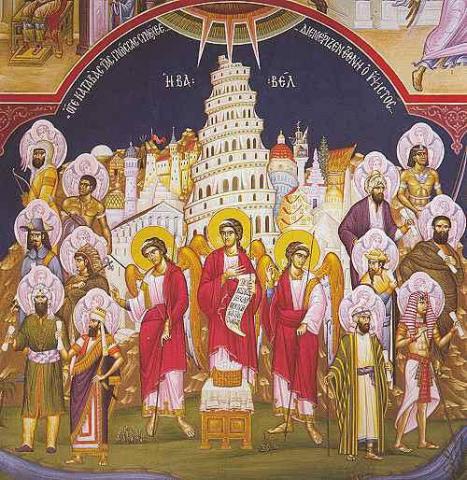
Abraham
ABRAHAM
Possible Lesson Plan:
- Open with prayer.
- Scripture reference: Genesis 12-20. Quite a few chapters! How about having each student read a chapter and summarize it for the group? They should look for factual content (What happened? To whom? Where?) and also spiritual content (Why did it happen? Lessons for today?). Take some time to trace Abraham’s journey on a map. Make a copy of the map for each student to use as he reads the Scripture reference and connect the lines so each member has a complete “journey”.
- Service References: Abraham’s gifts to Melchizadek, priest and king of Salem in Genesis 14: 18-20, is the introit to Liturgy on Christmas, “From the womb before the morning star have I begotten Thee. The Lord hath sworn and will not repent: Thou art a priest forever after the order of Melchizadek.” This event is also commemorated in the reading from Hebrews (7:7-17) in the liturgy of the Meeting of Our Lord. Abraham gave homage to Christ Himself in the person of Melchizadek, according to the writer of Hebrews. Why would Melchizadek be referenced in these two feasts?
Another event in the life of Abraham, the entertaining of the three men in Genesis 18:1-16, is contained in the answer of the angel to Mary on Annunciation when she asks how her womb could contain “Him whom the wide spaces of the heavens cannot contain? ‘O Virgin, let the tent of Abraham that once contained God teach thee: for it prefigured thy womb, which now receives the Godhead.’” Church tradition, shown in the famous icon of the 3 persons of the trinity sitting at a table, sees the three men as the three persons of the Trinity. What do you think?
God’s blessing the marriage of Abraham and Sarah is referenced in the marriage rite. What aspects of their marriage were admirable? Which not so admirable?
St. Andrew of Crete, in his canon, sung the first week of Great Lent, exhorts us “Having heard, O my soul, how Abraham left the land of his ancestors to become a wanderer, imitate his resolution. At the Oak of Mamre the Patriarch Abraham offered hospitality to angels, and in his old age inherited the prize of God's promise. O my wretched soul, knowing Isaac to be a new sacrifice mystically offered to the Lord, imitate also his resolution.” Do we have the perseverance of Abraham to follow God’s path?
- Discussion: Today’s emphasis should be faith; the New Testament book of Hebrews showcases the faith of Abraham. After all, God called Abram to leave his home and father a nation, with a wife who was old and childless. His story targets for us the way God summons us to leave the safety and security of their daily lives to follow Him. In that sense, Abram is not that different from all of us, but how many of us are like Abraham? What is the difference between Abram and Abraham? When and why did he get the new name? How would we have responded to the command to leave our homes? What faith qualities did Abram exhibit? Was he perfect? Examples?
Get a little exercise after all this reading: Get up and tell the students to follow you. Lead them somewhere else in the house. Ask them, if you’d been Abram, what three questions would you have had for God before beginning the journey? Now have them hold hands in a long line and close their eyes; lead them back. What feelings did they experience? What feelings might Abram have experienced?
What people do they know who have demonstrated faith? Give an example of their faith in action. Has anyone had a recent experience that caused him or her to take a risk totally on faith? How did it work out? Why? If God needed something done right now and called on us to do it, what faith qualities do we have that would help us get the job done? Have students each make a list. What faith qualities still need some work?
- Close with prayer: Have each student pray (either aloud or silently) about an area of faith where he needs growth.
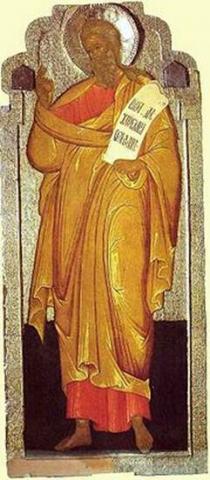
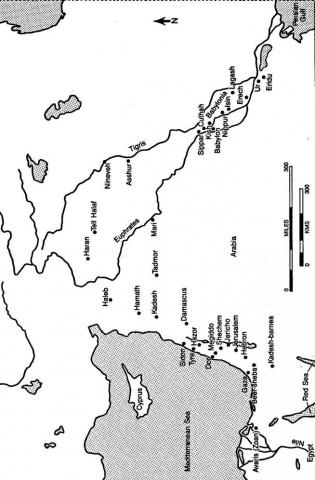
I
Isaac
ISAAC
Possible Lesson Plan:
- Open with prayer.
- Scripture Reference: Genesis 21-25:11 -- not quite so long this time. Have the students read the lesson silently. Then give each a slip of paper with a scene from the reading described on it. Have the student draw the scene (as in Pictionary) and the others guess what event it is. Some scenes to try might be:
Abraham throwing out Hagar and Ishmael
An angel showing Hagar and Ishmael the well
Abraham taking Isaac to be sacrificed
Abraham finding the ram for the sacrifice
Abraham’s servant meeting Rebekah at the well
Abraham buying the cave to bury Sarah
Isaac meeting Rebekah
Isaac and Ishmael burying Abraham
Try doing each scene on a separate piece of paper. If the students want to, they can then color the scenes and present a storybook for the younger children at next week’s opening exercises. What does Isaac’s name mean (“one laughs”) and what event gave rise to the name?
- Service references: St. Ann is compared with Sarah in the matins of the feast of the Nativity of the Theotokos: “O Lord, Thou hast opened the womb of Sarah, giving her Isaac as fruit in her old age. Today, O Savior, Thou hast likewise given to godly Ann a fruit born from her womb, even Thine own Mother without spot.” Ann was barren, as was Sarah. Other parallels? The story of the sacrifice of Isaac by Abraham is read on Holy Saturday. What parallels are there between the sacrifice of Isaac and the sacrifice of the Son of God? Contrasts? The marriage of Isaac and Rebecca is also referenced in the sacrament of marriage. What aspects of their union are admirable? Not so admirable?
- Discussion: There is first historical importance to the family of Abraham. Begin a family tree with Abraham and Sarah. Add Hagar, Ishmael, and Isaac. Getting complicated? Now add Abraham’s brother Nahor, his wife Milcah, their children, and their son Bethuel’s daughter Rebekah and son Laban. Now Rebekah needs to marry her first cousin once removed Isaac. Now don’t forget Keturah, Abraham’s new wife after the death of Sarah, and all of her sons. What a mess! What peoples descended from this complicated family? Who are the sons of Ishmael today? (the Arabs) Who are the sons of Isaac? (the Jews) Any doubt that history from thousands of years ago can still affect world politics? What is the present status of the nation of Israel? The Palestinians? Who said history was dead!
Briefly talk about faith again. Abraham’s taking of Isaac to be sacrificed is often considered one of the greatest examples of faith in the Bible. What would it cost to kill your own child? How could he have even considered such a thing? Any doubts that it was really God speaking to him? What about dating and marriage customs? How was a bride found for Isaac? How is a bride (or groom) sought today? Pros and cons of each method? Brainstorm. Would you leave your home and family on a camel with a servant to travel to a husband you’ve never seen? Example of faith?
- Close with prayer: Say a special prayer for peace between the children of Abraham and their descendants.
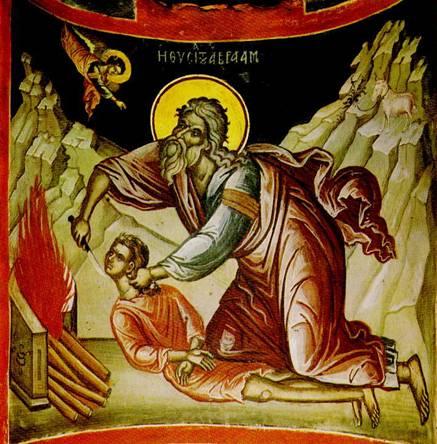
J
Jacob
JACOB
Possible Lesson Plan:
- Open with prayer.
- Scripture reference: Genesis 25:21-34, chapters 27-33. Lots of new people to meet in these chapters. How about giving each student a character – Laban, Leah, Rachel, Esau, Jacob – or a place – Beersheba, Bethel, Haran, Mizpah – summarize a biography or history of the place: who, what, when, where, why? Add Rachel and Leah to your growing family tree. What is the meaning of the dream about the ladder going to heaven? Why did God give Jacob this dream? How did Jacob change? Who is Israel and why?
- Service References: The vision of Jacob’s Ladder in Genesis 28:10-17 is the reading for the Nativity of the Theotokos at vespers and again in the vespers of the Annunciation. Why? In matins of Annunciation an explanation is given – that the Ladder is a prefigurement of Mary: “The Holy Scriptures speak of thee mystically, O Mother of the Most High. For Jacob saw in days of old the ladder that prefigured thee, and said: ‘This is the stair on which God shall tread.’ Therefore, as is meet, dost thou hear the salutation: ‘Hail, thou who art full of grace: the Lord is with thee.’” She is again referred to as the “heavenly ladder” in the eighth tone of weekly vespers. How is Mary a ladder to heaven?
In the canon of St. Andrew of Crete, sung during the first week of Great Lent, the saint views the ladder in this way: “The ladder which long ago Jacob the great patriarch saw is for you, O my soul, an image to consider. The bottom most rung is a first step towards doing the will of God, while those that follow lead to a true knowledge of Him. Therefore, renew your Life if you wish to do God's work, to receive knowledge and insight.” – a true Lenten climb!
When Jacob blessed the 2 sons of Joseph (Who are they?) in Genesis 48:14, he crossed his hands. In the vespers of the feast of the Holy Cross, St. Cyprian says: “The crossing of his hands by the Patriarch Jacob at the blessing of his children foreshadowed the mighty token of Thy Cross.” Why did Jacob cross his hands? How did that foreshadow the cross?
Genesis 49:1-12 is read on Palm Sunday. Read the prophecies about Judah – “he whom thy brethren shall praise…binding his … ass’s colt unto the choice vine…his clothes in the blood of grapes…” Prefigures Christ?
Finally, the marriage of Jacob with Rachel (but not Leah?) is again referenced in the marriage service. Why?
- Discussion: We have here an entire group of cheaters and liars! Who? When? What about Jacob and Esau, Laban with Leah, Laban with the wages, Rachel with the household idols? Teens must make moral choices every day. Cheating is one that frequently confronts them. There are plenty of opportunities to cheat in the high school environment. Examine the different aspects of cheating and how a Christian student can cope. How prevalent is the practice of cheating? Let the students share their gripes about cheating: giving an unfair advantage, some teachers make it easy (like Isaac being blind?), etc. What percentage of the students at each teen’s school cheat? Why do they cheat? List some reasons (e.g. laziness, too busy to study, pressure to get good grades, everybody else does it, etc.) and rank them from best to worst. Are there times when a student has to cheat? Is cheating worth the risk?
What is the definition of cheating? Ask the students if the things listed below would be serious cheating, barely cheating, or not cheating at all:
- Copying from someone else’s test paper.
- Writing the answers for the test on your arm.
- Getting the answers from someone who took the test last period.
- Letting a friend copy answers from your test.
- Using a test from last year as a study guide.
- Copying an answer from someone else’s homework.
- Letting someone copy an answer from your homework.
Which are active cheating? Passive cheating? Did Jacob actively cheat Esau? Laban and Jacob? Is cheating OK as long as you don’t get caught? What were the results of Jacob’s cheating Esau? Laban cheating Jacob? Does cheating finally “catch up with you”? Rachel lied about the household idols. Jacob lied to Isaac. Why did they lie? Is there a difference between a “little white lie” and a real lie? Give examples of what you would classify as a “little white lie” and a real lie. Is a lie really a lie if the intention is good? What reasons would justify telling a lie? Brainstorm here: To get out of trouble, to protect a friend, to avoid hurting another’s feelings, to keep a secret, to get something you haven’t earned… Is there a difference between lying and not telling all the truth?
Bring the lesson home: When was the last time you lied? Cheated? Why? Could you have avoided it? How? What were the consequences? Did you feel comfortable telling the lie? Cheating? Is there a lie you wish you could untell?
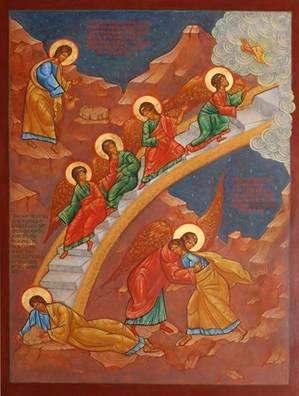 Close with prayer: Pray for the strength to act and speak the honest truth for the entire week.
Close with prayer: Pray for the strength to act and speak the honest truth for the entire week.
Joseph #1
JOSEPH #1
Possible Lesson Plan:
- Open with prayer.
- Scripture Reference: Genesis 37. The story line here is very simple and the teens probably know it. Read it briefly. We meet here the sons of Israel. While their names may seem unimportant, actually we’ll meet them again and again as the tribes of Israel. Try 20 questions with Joseph, Reuben, Judah, and Benjamin (and add Potiphar for some spice, and Rachel, Leah, and Israel if there are lots of students). Add the sons to the family tree, being sure to note sons of Rachel (and her servants) vs. sons of Leah (and her servants).
- Service References: The services are full of references to the descendants of “Abraham, Isaac, and Jacob” and the genealogies show Jesus to be descended from Judah, older brother of Joseph, son of Leah. In the Canon of St. Andrew of Crete, sung during the first week of Great Lent, St. Andrew laments: “I confess my sins to You, O Christ my King, like Joseph's brothers have I sold into slavery him who was chaste and pure.As an image of our Lord was that righteous soul cast out by his brothers and sold into slavery, while you, my soul, have sold yourself into your own evil hands.O suffering and hopeless soul, imitate the purity of mind in righteous Joseph, and do not sin by being led astray by irrational desires. Joseph's being placed in a pit formed an image of Your burial and resurrection, O Lord and Master. Will I ever be able to endure such things for Your sake?” – a question we can still ponder today. Am I more like the brothers, or becoming more like Joseph? In what way is the pit like the burial of our Lord?
- Discussion: Talk about dysfunctional families! This one is phenomenal! Be careful in this discussion since many of your students may be from families with divorces, splits, etc., also. Have the students describe their favorite memory of family life. Their least favorite? How would Joseph and his brothers have answered this same question? Do our families have a great influence over our future? A little? How important is the family? How has your family influenced you?
Joseph was a teenager when the events of this chapter occurred. Do teens have an obligation to their families? Brainstorm for particulars here. Families to their teens? Again, be specific. What sort of relationship should there be between brothers? Between parents and children? What is the reality in the family of Joseph? What is the reality in your family? Are you getting as much out of family life as you can? Are you giving as much as you can?
Whose “fault” was the events of the story? What part did Jacob play? Joseph? The brothers? How could each of them have changed their own behavior in such a way that the disastrous events of the end of the chapter could have been avoided? Looking back to each student’s least favorite family event (not necessarily out loud): Who played a role? How could things have been different? Is there a particular person or situation who seems to be the focus of the family’s problems?
We have Joseph’s family tree. What about doing a family tree for each student. Start in class with what the student knows – parents, siblings, grandparents, aunts, uncles, cousins. Take it home to work on with the parents for earlier generations.
- Close with prayer: Pray specifically for the person or situation the student has identified as a problem focus in his family.
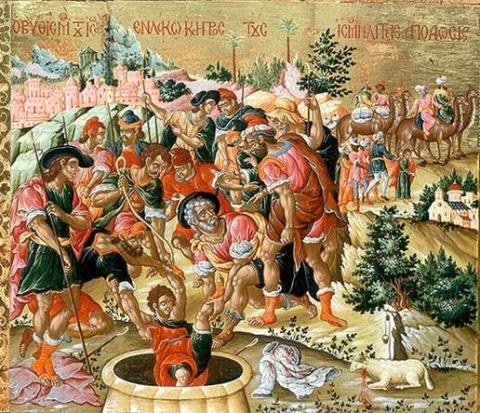
Joseph #2
JOSEPH #2
Possible Lesson Plan:
- Open with prayer.
- Scripture Reference: Genesis 39-45. Give each student a question to find the answer to as he reads, such as:
Why was Joseph in Egypt when the rest of his family were in Canaan?
Why was Joseph in prison in Egypt?
What interpretation did Joseph give the butler and the baker?
How did Joseph help the Egyptian Pharaoh?
Why did Jacob send his sons to Egypt with money? Why not Benjamin?
Which brother stayed in Egypt while the others went to get Benjamin & why?
How did Joseph test his brothers to see if their hearts had really changed?
How did Joseph reveal his identity to his brothers?
And, for the whole class, how did God bring something good out of the evil Joseph’s brothers did to him?
- Service References: In the Bridegroom services of Holy Week, Joseph is honored in the Kontakion: “Jacob lamented the loss of Joseph but his noble son was seated on a chariot and honored as a king. For when he refused to be enslaved by the pleasures of the Egyptian woman , he was glorified by the Lord who beholds the hearts of men, and bestows upon them an incorruptible crown.” And again in the Aposticha, “The serpent found a second Eve in the Egyptian woman and plotted the fall of Joseph through words of flattery. But, leaving behind his garment, Joseph fled from sin. He was naked but unashamed, like Adam before the fall.” In what way was Potiphar’s wife similar to Eve? How did Joseph’s actions differ from Adam’s? The results?
Eventually, Joseph married in Egypt and had two sons with his wife, Asenath. Their union is also remembered in the marriage service. Why?
- Discussion: Life is unfair, but it was particularly unfair to Joseph. Have you ever been treated unfairly? If anyone was entitled to a grudge, it was Joseph. List the ways people wronged Joseph on the board and, next to each, how Joseph responded. Did God seem to fail Joseph? If you were in Joseph’s place, how would you have responded? To the situations? To God?
Ask the class about situations they would find hard to forgive: with their friends? With their parents? Brainstorm and list them on the board. What is the one thing someone could do that you could never forgive? Write that on a piece of paper. Would you want others to see it?
We always have choices. Adam and Eve had a choice in the garden. Joseph had a choice; he had every right not to forgive his brothers, or did he? Should we always forgive, no matter what the circumstance? Are there some things that can never be forgiven? Do others have to apologize before being forgiven? Is forgiveness even possible? Is there anyone in my life I have not forgiven? Why? What are the consequences of my not forgiving this person to the person? To myself?
- Close with prayer: Have each student think of a person he or she needs to forgive. Ask God to help them forgive.
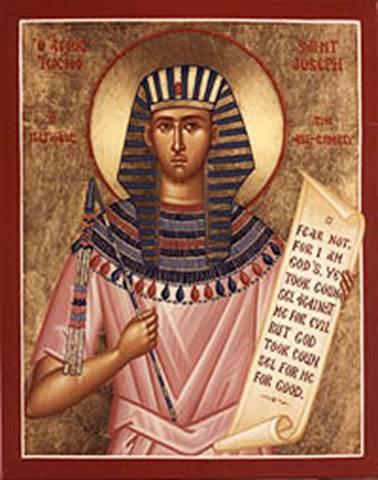
M
Moses #1 (early life)
MOSES #1
Possible Lesson Plan:
- Open with prayer.
- Scripture Reference: Exodus 2-14. Whew! Another long one…Use these references and cut them apart for each student to read one or two out loud: Cut apart to have a couple of readings for each student:
Moses found by Pharaoh’s sister Exodus 2: 1-10
Egyptian beating Hebrew Exodus 2: 11-12
Moses cast out of Egypt Exodus 2: 13-15
Moses at Jethro’s well in Midian Exodus 2: 16-17
Moses married Zipporah Exodus 2: 21-22
The burning bush Exodus 3: 1-6
I am Who I Am Exodus 3: 11-14
Moses is afraid to go back to Egypt Exodus 4:1-5, 10-13
Bricks without straw Exodus 5:1-7, 22-23
Nile into blood Exodus 7:14-18
Frogs Exodus 7:26-29, 8: 1-8
Lice Exodus 8:12-15
Flies Exodus 8:16-20
Cattle disease Exodus 9:1-7
Boils and sores Exodus 9: 8-12
Hail like fire Exodus 9: 22-25
Locusts Exodus 10:3-6, 16-20
Darkness over the land Exodus 10:21-23
Passover Exodus 12:11-14, 26-28
The Exodus – the departure Exodus 12: 30-36
Parting of the Red Sea Exodus 14:13-25
Death of Pharaoh’s army Exodus 14: 26-31
- How about writing the salient events of the chapters on cards, mixing them up, and having the students put the cards in chronological order and say one sentence about each? Try these:
Moses found by Pharaoh’s sister Egyptian beating Hebrew
Moses cast out of Egypt Moses at Jethro’s well in Midian
Moses married Zipporah The burning bush
I am Who I Am Bricks without straw
Nile into blood Frogs
Gnats Insects
Cattle disease Boils and sores
Hail like fire Locusts
Darkness over the land Passover
Parting of the Red Sea Death of Pharaoh’s army
- Service References: Moses and his exploits comprise the largest group of references, beginning with the reading of the story of his being drawn from the river in Exodus 2:5-10 for Theophany vespers. Why would this reading be appropriate?
The burning bush is referenced at matins of the Nativity of the Theotokos:
“The bush on the mountain that was not consumed by fire…plainly prefigured thee, O Bride of God. For in a material womb, unconsumed thou hast received the divine and immaterial fire.” Again, at Christmas, “Plainly foreshadowed by the burning bush that was not consumed, A hallowed womb has borne the Word…” and at the Annunciation, “The bush that burnt with fire and yet remained unconsumed, disclosed the secret mystery that shall come to pass in thee, O pure Maiden, full of grace. For after childbirth thou shalt remain ever-Virgin.” The reading for vespers at the Annunciation is the story of the burning bush, Exodus 3:1-8. How is Mary like a bush??? Many types of fire are referenced at Pentecost. Why? “The unconsumed bush which mingled with fire in Sinai made God known to the heavy-tongued and hoarse-voiced Moses.” Parallels between Pentecost and the disciples’ speech?
Passover is a regular visitor in Orthodox services. The Resurrection of Christ is even called Pascha, Passover. In the matins service of Theophany, the baptism of Jesus is compared with Passover: “Let us, the faithful, keep ourselves safe through grace and through the seal of baptism. In the past the Hebrews fled destruction by marking the door posts with blood; so also this divine washing unto regeneration shall be our Exodus, and going hence, we shall behold the light of the Trinity that never sets.” On Great and Holy Thursday, “And since thou art the Passover, thou didst offer thyself to those for whom thou wast about to die, saying, Eat ye my Body, and be established in the Faith.” “And in the ninth hour Jesus, the Lamb of God, who took away the sins of the world cried with a loud voice, It is finished, and gave up the ghost, at the very hour in which the Lamb of the Mosaic Passover was being slaughtered, which the Jews had been commanded to sacrifice every year as a symbol of Him…” Indeed Jesus had come to Jerusalem because it was the feast of Passover. And, on Great and Holy Saturday, the Law given to Moses concerning Passover from Exodus 12:1-11 is read. In Ode 4 of the Paschal Canon, the Church states, “Christ our Pascha has appeared as a male child, the Son that opens a virgin womb. He is called the Lamb as one destined to be our food, Unblemished for He has not tasted of defilement, and perfect for He is our true God.” Did Jesus meet the criteria for the Paschal sacrifice? Parallels with Passover and Pascha?
The parting of the Red Sea is also of great importance to the Church. The path through the sea is our path to salvation at Christmas in the second canon: “Of old the Master that works wonders saved His people, Making the watery wave of the sea into dry land; And now of His own will has He been born from a Maiden, And so He establishes a path for us whereby we may mount to heaven.” The story from Exodus 14 is read on the feast of Theophany at vespers; in the canon “The sea and cloud in which the people of Israel were once baptized by Moses the Lawgiver, as they journeyed from Egypt, prefigured the wonder of the baptism of God. The sea was an image of the water and the cloud an image of the Spirit…” and in the blessing of the waters “Thou art our God who, through the waters of the sea, at Moses’ hand hast set free the Hebrew nation from the bondage of Pharaoh.” What parallels do you see between Theophany and the parting of the Red Sea? In his Canon, St. Andrew of Crete says “Think of the staff that Moses stretched over the waters to divide them. It is an image of the Cross of Christ” and thus the parting of the Red Sea is also referenced by the Church at the feast of the Holy Cross: “Inscribing the invincible weapon of the Cross upon the waters, Moses marked a straight line before him with his staff and divided the Red Sea, opening a path for Israel who went over dry-shod. Then he marked a second line across the waters and united them in one, overwhelming the chariots of Pharaoh”. Even the manger becomes involved at the forefeast of Christmas with “He who in ancient times hid the pursuing tyrant beneath the waves of the sea, is hidden in a manger and Herod seeks to kill Him.” And that same “pursuing tyrant” gets into the act in the canon of the Holy Saturday matins: “Of old Thou didst bury the pursuing tyrant beneath the waves of the sea. Now the children of those who were saved bury Thee beneath the earth.” Who is the pursuing tyrant? How is the sea the manger? The grave? Miriam’s dance for joy prefigures the praises of the Dormition of the Theotokos at matins with “Thy sacred and renowned memorial, O Virgin…has brought all the faithful together in joy, and led by Miriam, with dances and timbrels, they sing the praises of thine Only-begotten Son…”
- Discussion: Begin by discussing natural disasters today. Bring some articles from a news magazine or newspaper about some recent earthquakes, floods, storms, etc. How did these disasters affect the people involved? How would each of the plagues of Egypt have affected Pharaoh? The common people? Which plague would have been the worst for you to experience? Why?
God asked Moses to do something very difficult. Has God ever asked you to do anything you felt was very hard? Moses was afraid to go to Pharoah. Why? What makes you fearful? How does fear affect our ability to trust God? Did Moses overcome his fear? What were the results? How can we overcome our fear?
What struggle is going on between Moses and Pharaoh? Why is Pharaoh so arrogant? If you’d been in Pharaoh’s position, how would you have responded to Moses? Why was Moses so persistent? Has persistence ever worked for you? In athletics? In school? In what situations? Did you ever give up and quit? What did you learn from the experience? Even after Moses brought them out of Egypt by God’s power, the people again doubted when they saw Pharaoh’s chariots coming after them. Does doubt affect your ability to persist through rough times? What does faith have to do with persistence?
- Close with prayer: As each student to think about one area in his life in which he needs more persistence. Pray about these areas and pray for each other during the week.
Moses #2 (later life)
MOSES #2
Possible Lesson Plan:
- Open with prayer.
- Scripture Reference: Exodus 16, 19-20, 32 and Numbers 13-14, 20-21, Deuteronomy 34. Again, a lot of reading. Again, cut apart these references and have students read them aloud in this order:
Manna Exodus 16: 1-4, 31
Water from a rock Exodus 17: 1-7
Mt. Sinai Exodus 19:3-6, 16-20
10 Commandments Exodus 20: 1-17
Golden Calf Exodus 32:1-5, 15-24
Ark of the Covenant Exodus 25: 10-16
Sending of the spies Numbers 13:23-33
Aaron’s Rod that budded Numbers 17:21-26, 18:1-2
Fiery Serpent Numbers 21:4-9
View from Mt. Nebo Deuteronomy 34: 1-4, 9-12
- Continue your time line cards with the following:
Manna Mt. Sinai
10 Commandments Golden Calf
Sending of the spies Water from a rock
Fiery Serpent View from Mt. Nebo
Follow the path of Moses on the map.
- Service References: Again we find the services of the church replete with references to the later exploits of Moses. At the feast of the Transfiguration, Exodus 24:12-18 and Exodus 33:11-34:8 are read. Of course, Moses and Elijah are seen with Jesus by the apostles at Transfiguration as in vespers: “The shining cloud of the Transfiguration has taken the place of the darkness of the Law. Moses and Elijah were counted worthy of this glory brighter than light and taken up within it…”, “Moses who saw God and Elijah who rode in the chariot of fire …beheld Thee in the cloud at Thy Transfiguration, O Christ, and they testified that Thou art the maker and the fulfillment of the Law and the prophets”, “Thou hast appeared to Moses both on the Mountain of the Law and on Tabor: of old in darkness, but now in the unapproachable light of the Godhead”, and “Talking with Christ, Moses and Elijah showed that He is Lord of both the living and the dead, the God who spake of old through the Law and the prophets.” Who represents the Law? The prophets?
God led the Israelites in the wilderness by a pillar of fire by night and a cloud by day. But, their gratitude is spoken to by the Lord in the Royal Hours: “And how have you now rewarded me? By returning evil for good. For the pillar of fire you nail me to the cross. For the cloud you dig me a grave.” How is the cross a pillar
of fire? The cloud, a grave?
God provided manna for the Hebrews to eat. Judas is seen as their son on Great and Holy Thursday with “In truth Judas is son of the vipers who ate the manna in the wilderness, and murmured against the Nourisher; for those ingrates, while food was still in their mouths, murmured against God. Similarly, this wicked one of false worship, while the heavenly Bread was still in his mouth, conspired to deliver the Savior.” And Jesus speaks to the Jews in the Royal Hours of Holy Friday, “My people, what have I done to you, and how have you repaid me? Instead of manna, gall; instead of water, vinegar.” He also provided water, which prefigures the water that flowed from the side of Jesus at his crucifixion: “Thy side was pierced, O Savior, like the rock of flint in the wilderness; but Thou hast poured forth a stream of living water, for Thou art the Fount of Life.” And in Ode three of the Paschal Canon: “Come let us drink, not miraculous water drawn forth from a barren stone, but a new vintage from the fount of incorruption, springing from the tomb of Christ.” The story of the waters of Marah, when Moses cast the tree into the waters and they became sweet, is read at the feast of the Holy Cross, with the explanation at matins, “In like manner of old did wood once destroy the bitterness of the waters of Marah, prefiguring the strength of the Cross that all the powers of heaven magnify.” In what way does each of these incidents – the manna, the water from the rock, and the waters of Marah – prefigure Christ? St. Andrew of Crete in his canon, sung during the first week of Great Lent, laments that we are much like the Israelites “Like Israel of old you have an arrogant will, O my soul, preferring gluttony and self gratification to the manna from heaven. The Canaanites' wells can be likened to worldly philosophies, from which you, my soul, have preferred to drink rather than from the rock from which when struck by Moses there poured out a river of wisdom, the knowledge of God. Like the arrogant Israelites in the wilderness, you prefer the comforts of Egypt and unclean food to manna, the food sent from heaven. Water pouring from the rock when struck by Your servant Moses, prefigured Your life giving side, O Saviour, from which we saw the Water of Life.
God gave the Law to Moses, the same Law that He Himself obeyed at the Meeting of the Lord. At Vespers, “Today He who once gave the Law to Moses on Sinai submits Himself to the ordinances of the Law,” and at matins “He who is borne on high by the cherubim and praised in hymns by the seraphim, is broug
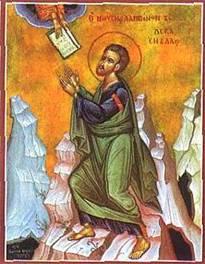
ht today according to the Law into the holy temple and rests in the arms of the Elder as on a throne. From Joseph He receives gifts fitting for God: a pair of doves, symbol of the spotless Church and of the newly-chosen people of the Gentiles; and two young pigeons, for He is the Originator of the two Covenants, both Old and New.” How are the 2 covenants different?
Aaron’s rod budded, choosing his line as priests according to Numbers 17:8. The cross of Christ in the matins of the feast of the Exaltation is compared to Aaron’s rod with “The rod of Aaron is an image of this mystery, for when it budded it showed who should be priest. So in the Church, that once was barren, the wood of the Cross has now put forth flower, filling her with strength and steadfastness.” And at the Nativity of the Theotokos, Mary is the “spotless branch of the root of Jesse, that brought forth Christ as flower.” The Cross is also prefigured in Exodus 17 when Moses “stretched out his arms in the form of a cross, the people became strong again” and Amalek was put to flight. Furthermore, the story of the serpents from Numbers 21 is referred to in matins of the Holy Cross with “Moses set upon a wooden pole a cure against the deadly and poisonous bite of the serpents: for crosswise upon the wood – as a symbol of the Cross – he placed a serpent that creeps about the earth, and thereby he triumphed over calamity.” In what way does each of these – Aaron’s rod, the battle with Amalek, and the pole of the serpent – prefigure the Holy Cross?
And, finally we arrive at the Ark of the Covenant, commanded by God for Moses to build. In it were placed the 10 commandments and Aaron’s rod. A tabernacle was built for the ark. Exodus 40 is read at the vespers of the Entry of the Theotokos. Why? Mary is called the “Heavenly Tabernacle” in a multitude of services, and here, at matins, “The Temple of God, the heavenly Tabernacle, accomplished her entry into the temple of the Law, and from her light has shone on us in darkness.” Mary says to the angel at Annunciation, “The descent of the Holy Spirit has purified my soul and sanctified my body: it has made of me a Temple that contains God, a Tabernacle divinely adorned…” and at her Dormition “Thy Son, O Virgin, has truly made thee dwell in the Holy of Holies as a bright candlestick, flaming with immaterial fire, as a golden censer burning with divine coal, as the vessel of manna, the rod of Aaron, and the tablet written by God, as a holy ark and table of the bread of life.” How is Mary like the Tabernacle? The Ark?
4. Discussion: What is the role of law in our lives? Designate one wall of the room as your ruler and put up the letter “A” at one end and the letter “B” at the other. Ask the teens these questions and have them stand anywhere between A and B depending on how they feel about the answer.
Without laws, society would be A.more civilized B. less civilized.
Rules at school should be A.open to change B. strictly enforced
Laws should be made by A. vote of the public B. the wisest people
Rules in the family should be made by A.vote of all B. parents
Following God is more like A. keeping the rules B.freedom of choice
Have teens explain their answers before moving on to the next question.
What do you feel about the laws given to Israel in the 10 Commandments? Which ones seem unfair? Which is most important? Least? Why did God give Israel laws? Which is hardest to keep and why?
The book of Numbers could be called the book of the 40-year goof. Israel made multiple mistakes along their journey. From your reading, what are some of them? (grumbling about food, grumbling about water, golden calf) Finally, they didn’t believe God could give them the land of Canaan. Each mistake brought punishment of some kind. What? Israel kept making the same mistakes over and over – grumbling, complaining. What was the underlying mistake? (lack of trust in God, maybe, let the teens brainstorm) And the final result was the 40 years in the wilderness. It’s very hard to decide on fair punishment. What would be a reasonable punishment if you broke your curfew and didn’t call to say you’d be late? If you cheated on an exam? Was God fair to Israel? Why or why not?
We all make mistakes, too. Have students list some of their own blunders, either privately or on the board. Were there consequences? Were they fair? Did we learn anything from our mistakes? Or do we, like Israel, make the same mistake over and over? Do we have a particular area in our lives we seem to have great difficulty in overcoming?
5. Close with prayer: Moses intervened with God in prayer many times to save Israel. Agree to intervene in prayer this week for each other in the area where mistakes seem greatest.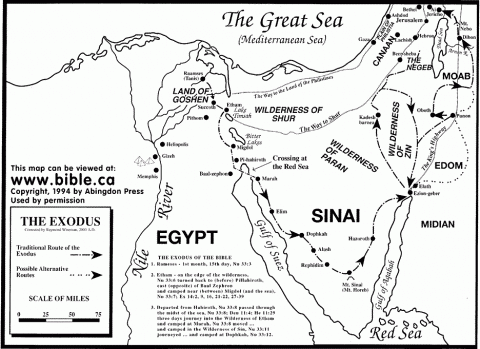
Balaam
BALAAM
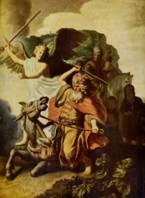
Possible Lesson Plan:
- Open with prayer.
- Scripture Reference: Numbers 22-24. This is a more esoteric story from the Scriptures and may be less familiar to the students. It is also a great story for kids – full of donkeys and flaming angels, bad guys and good guys. Have the students write a short skit (as if they were going to perform it for the smaller children in opening exercises next week) as a means of summarizing the material; if they really enjoy it, they can always actually do the performance!
- Service References: Balaam prophesies the Magi in the forefeast of the Nativity: “The riddles of Balaam, the soothsayer and diviner, are now fulfilled. For a star has dawned from Jacob and led the Magi, Kings from Persia bringing gifts, towards the Sun of Glory.” And “Thou hast filled with joy the watchers of the stars, who interpreted wisely the words of Balaam, the soothsayer of old.” Balaam’s words, “He shall rule over nations, and His Kingdom shall be exalted in grace and shall remain perpetually” refer to Christ according to the Nativity matins.
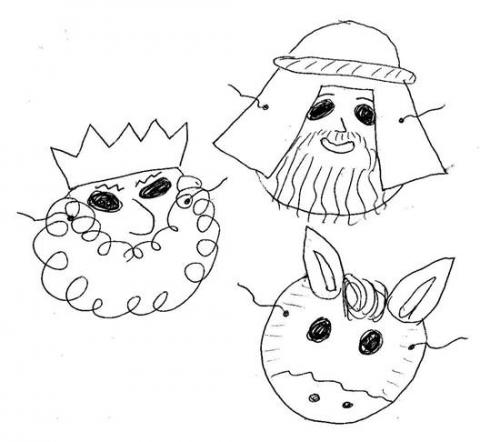 Discussion: Let’s take a break from deep discussions this week. Let the teens relax, make paper-plate masks for their skit, and practice it for the youngsters!
Discussion: Let’s take a break from deep discussions this week. Let the teens relax, make paper-plate masks for their skit, and practice it for the youngsters!
- Close with prayer.
Joshua
JOSHUA
Possible Lesson Plan:
- Open with prayer. We have already met Joshua. Where? He was one of the spies sent by Moses to report about the Promised Land. Of the twelve spies, only Joshua and Caleb believed God could give the Israelites this land; the rest were afraid and wanted to turn back to Egypt!
- Scripture Reference: Joshua 1-3, 6-11, 24. Another long section; but, don’t read it aloud in class. Have all the students briefly scan Joshua 1-3 and 24. Then, give each teen a particular battle to cover; have him or her prepare an army-style briefing (weapons, commander, location and identity of enemy, battle strategy) for the others from the master strategist, Joshua. Assign Joshua 6, Joshua 7, Joshua 8, Joshua 9, Joshua 10, and Joshua 11:1-15.
- Service References: On the feast of the Holy Cross and again on Holy Saturday, we read “Joshua, the son of Nun, stretched out his arms crosswise, O my Savior, mystically prefiguring the sign of the Cross: and the sun stood still until he had defeated the enemy that resisted Thee, O God. And now this same sun is darkened, seeing Thee upon the Cross destroying the power of death and despoiling hell.” What is the relationship between the cross and the sun in each instance?
Of course, the crossing of the Jordan is considered to prefigure Theophany. Joshua 3:7-17 is read at vespers of Theophany and at matins we hear, “Of old the Jordan was parted in two, And the people of Israel passed over on a narrow piece of dry land, Prefiguring Thee, O Lord most powerful, Who now makest haste to bear the creation down into the stream, Bringing it to a better and a changeless path.” Joshua and Jesus both went to the Jordan: compare and contrast. How did one prefigure the other?
St. Andrew of Crete, in his canon, sung on the first week of Great Lent, exhorts us all “Find the Promised Land and explore it secretly as Joshua, son of Nun, once did. See what kind of land it is and settle there, obeying the Law of God… As Joshua subdued Amalek and the lying Gibbeonites, arise, O my soul, and subdue the weakness of your flesh, subduing everything which leads your mind astray.” What enemies do I need to defeat? How can I enter the Promised Land?
- Discussion: Canaan contained many city-states, each with its own king, who joined together to fight a common threat, the Hebrew people. And the Canaanites were not about to allow the Hebrews to take their land without a fight. The Hebrew people were also composed of 12 tribes, each bound to help the others claim their inheritance before settling down in their own land. So, too, teens face numerous battlegrounds in their desire to serve the Lord and must work together to gain victory.
Begin by forming 2 teams of 4 people each. Each team will consist of a farmer, a chicken, a bag of grain, and a fox. The chicken, grain and fox must all be carried across the river by the farmer; none can move without being carried. The farmer can carry only one at a time. The foxes cannot be left alone with the chickens or they’ll eat them; the chickens cannot be left alone with the grain without eating it. See which team can successfully complete the task soonest. Did teamwork help?
Ask a series of “battle questions”; allow each student to answer each:
The toughest battle I fighting now is…
In my faith, I constantly battle the question of…
The battle I fight most often with my parents centers around…
At school, one battle I fight continuously is…
My friends and I seem to battle most about…
A promise I have made but failed to keep is…
How do we decide if something is worth fighting for? Do we ever get tired of fighting battles? Why or why not? Joshua did not fight each battle the same way, but, with God’s help, His people won battle after battle. Is there one battle right now you’re fighting that you feel you must win? Is God helping you fight? How? Are your Christian friends helping? How? Or how could they?
- Close with prayer: Pray for each battle the students have mentioned that they will have the wisdom and faith of Joshua with the help of their fellow-Israelites to win the battles.
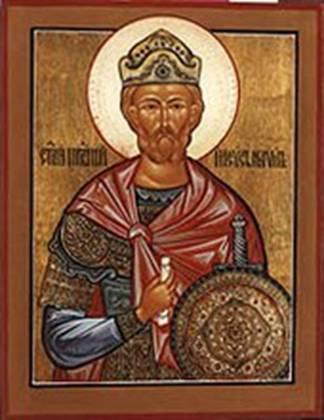
Judges/Gideon
JUDGES/GIDEON
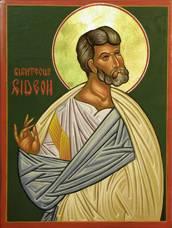
Possible Lesson Plan:
- Open with prayer. When the Israelites entered the Promised Land, they were not ruled by a king but by judges appointed by God. God had commanded Moses to build the Ark of the Covenant (remember what was in it?) and the Tabernacle – a huge tent, greatly decorated, holding the precious Ark. During the years of wandering, the Levites carried this huge tent and all of its furnishings, to be set up at each new camping place. In the Promised Land, the Tabernacle was set up at a place named Shiloh. The people came to Shiloh to pray and to give offerings to God. On the Day of Atonement each year, the high priest would sacrifice a goat as an offering to the Lord and send another goat out into the wilderness to show that the people’s sins were sent far away. On this holy day, celebrated from the days of Moses until today, the Jewish people fasted and prayed.
- Scripture Reference: Judges 3, 4, 6-8, 13-16. The book of Judges traces the Hebrew people’s struggle with adversity and prosperity. The people bounced back and forth between serving the Lord and following the idols of Canaan. Each time God sent judges to bring the people back to himself. Assign groups of students Judges 3, Judges 4, Judges 6-8, Judges 13-16. Have each prepare a biography of the judge described in the chapter: the situation he or she faced, the cause of the problem, how he or she dealt with it, and the outcome of the situation. Here is some useful data to help summarize, especially if there are not enough students to handle all of the judges.
- Service References: The fleece of Gideon prefigures Mary, the Theotokos. At Christmas, “For as rain upon the fleece hast Thou descended into a virgin womb…” And at Annunciation, “Gideon saw thee as a fleece…” How did the fleece prefigure Mary? The dew, Christ? The fleece also prefigures Theophany, in the matins service: “The fleece that Gideon saw prophetically, from which he wringed a bowl full of water, clearly disclosed the baptism, O Christ…” How?
- Discussion: Let’s look more fully at Gideon. Why was God angry with the Israelites? Why did God bother to save them at all after their consistent rebellion? How did God call Gideon? How did Gideon destroy Baal? Why? What was the purpose of the fleece? How did Gideon select his men? How did he win the battle? Was Gideon stupid to go into battle with such odds against him? Why or why not? Why did the Hebrews prosper when a judge was alive?
We also have times of prosperity and times of adversity, just like the Hebrew people. Have each student rate each month of the past year on a scale of 1-10 – 1 being really bad times and 10 being really good times. Why was each month rated as it was? Should Christians expect all good times simply because they believe in God? Did you cause any of the months of adversity yourself? How? Why?
What similarities do you see between yourself and Gideon? Differences? In what ways was God at work in Gideon’s life? In yours? How did he speak to Gideon? To you? When did Gideon face seemingly impossible odds? Have you ever faced seemingly impossible odds? Are there any conclusions we can draw from Gideon’s life about God’s work in our own lives?
- Find the tribes of Israel on the map. Where was Gideon? Other judges? OK, a lot to learn here. How about making it fun with a game of Judges Bingo. The call list gives you the information, to share with the students as you call the picture.
- Close with prayer: Ask the students if they are facing an adversity they’d like the group to pray about. Offer these up in prayer and continue to intercede during the week for each other.
Job
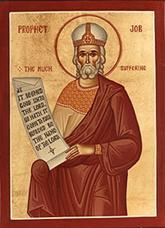 JOB
JOB
Possible Lesson Plan:
- Open with prayer.
- Scripture reference: the book of Job. Instead of reading the whole book in class, an impossible task, try a summary reading. Assign the parts of Narrator, Lord, Satan, Job, Eliphaz, Bildad, Zophar, and Elihu. Have the appropriate student read these passages in this order to summarize the book:
Narrator – 1:1-4, 6 Lord – 2:2a Bildad – 18:2-4
Lord – 1:7a Satan – 2:2b Job – 19:1-7, 21-22
Satan – 1:7b Lord – 2:3 Zophar – 20:4-9
Lord – 1:8 Satan – 2:4-5 Job – 27:5-6
Satan – 1:9-11 Lord – 2:6 Narrator – 32:1-6
Lord – 1:12 Narrator – 2:7,11-13 Elihu – 33:8-28
Narrator – 1:13-20 Job – 12:4 Lord – 38:1-12,40:1-2
Job – 1:21 Eliphaz – 15:12-16 Job – 40:3-5
Narrator – 1:22, 2:1 Job – 16:1-3 Lord – 40:7-14
Job – 42:1-6
End with everyone reading Job 42:10-12
- Service References: Job is read on the Vespers of Holy Friday, where it is said that he will rise again with “those whom the Lord will raise”. The “patience of Job” is also called upon in the service of Holy Unction; why? And, in the Canon of St. Andrew of Crete, sung during the first week of Great Lent, we are exhorted: “Job, whom God deemed more righteous and blameless than anyone else alive, did not escape the traps of the deceiver, so what will you do, O my sin-loving soul, if something unexpected befalls you?...My soul, have you not heard of Job, who even while sitting on a dunghill was justified? Why then in times of temptation have you never imitated his courage or firmness of purpose, or endured with patience?” How can you respond like Job to situations in your own life?
- Discussion: The book of Job centers on suffering. Here we find a good man who encountered one disaster after another. What did Job suffer? Did his friends help him? Why did his friends fail to help him? How would you have reacted if they had been your friends? Why did Job decide he wanted to die? How do you feel about that decision? What or who do you think causes suffering in the world?
Ask the class to list some forms of suffering in the world (e.g. cancer, starvation, AIDs) Why is there so much suffering in the world? How could a good God allow such suffering? How can we bring hope to those who suffer? If you want, you could stop right now and make cards for people suffering – in a hospice, a nursing home, a prison, etc. Who will deliver them?
Have each student consider a time he or she suffered. Do you think God is punishing you for the suffering? On a scale of 1-10, with 10 being the maximum suffering, where would you rate the suffering you’ve experienced so far in life? Can following God cause us to suffer? How have you learned to survive rough times?
- Close with prayer: Have each student think of someone he knows is suffering now and pray for that person. Plan to do something to reach out to that suffering person this week.
Note: If the students are really wrestling with the question of suffering, suggest the book The Problem of Pain by C.S. Lewis, available at any library.
Ruth
RUTH
Possible Lesson Plan:
- Open with prayer.
- Scripture Reference: the book of Ruth – a short book. At the start of class, give each student a charade. Then have them read the book silently and prepare to act out their scene for the class. The class can guess which scene is being portrayed:
Death of Naomi’s husband Naomi parting with Ruth and Orpah
Ruth gleaning in the fields Ruth meeting Boaz
The threshing floor Boaz redeeming the land
Marriage of Boaz and Ruth
- Service References: Ruth, the Moabitess, is listed in the geneology of Jesus in Matthew, read a Christmastime.
- Discussion: While the story of Ruth contains no battles or heroic acts, it gives us the opportunity to understand the importance of loyalty in relationships with people and with God. Ruth lived in the time of the Judges. Have the students list the positive qualities they see in Ruth (e.g., obedient, loving, hard-working, etc.). What about Naomi? Boaz? In what ways did Ruth show herself to be loyal? Was she the sort of person who did things to be noticed? Did she seem to have a lot to offer? Yet, in the end, Ruth became an ancestress to King David and through David to Jesus Himself. Why is this important?
Break into 3 groups and have each group list 5 ways to answer:
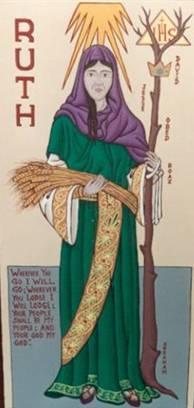 In a friendship, loyalty means…
In a friendship, loyalty means…
In a family, loyalty means…
In a relationship with God, loyalty means…
Have the groups share their answers with the wholegroup. Who or what are you most loyal to? Are there specific ways you can show that loyalty? What does loyalty have to do with character? Have you ever experienced broken loyalty in a friendship? In your family? In your relationship with God? How do you feel when someone has been disloyal to you?
- Close with prayer: Have students pray for any ongoing situations of broken loyalty, either their own or others to them.
Hannah/Samuel
HANNAH/SAMUEL
 Possible lesson plan:
Possible lesson plan:
- Open with prayer.
- Scripture Reference: I Kingdoms/I Samuel 1-4. Chapters 1-3 make a good children’s story, while not being as well known as Noah and the Ark or David and Goliath. As the teens read, have them decide on how they would present this story in flannelgraph form: what characters do they need, what background features to distinguish the places, how they would tell the story. Most teens babysit, even guys on occasion. If you want, get each teen a clean pizza box (pizza places will give you a few of these for church if you ask), cover the inside bottom of the box with light blue felt (buy by the yard at a fabric store), take some squares of felt of different colors (we have these), and have the teens each make a storybook box to carry with them when they babysit. Have them practice telling the story with their figures.
- Service References: “Hannah, the Prophetess of old, drawn near with contrite spirit to the mighty God of intelligences, by her prayer alone undid the bonds of the barren one’s womb, and the hard rebuke of her with children.” This is read in the matins of Ascension. Why would she be mentioned here?
- Discussion: Samuel is known as the last of the judges and the first of the prophets. Samuel is known as the last of the judges and the first of the prophets. What is a prophet? A
prophet is a person called by God to deliver His message to His people. Samuel was held in high esteem throughout Israel and anointed the first two kings of the nation, Saul and David. We’ll meet him again the lives of these kings.
But, here we deal mostly with his birth and childhood, remarkable enough in themselves. What did his mother Hannah pray for? Why? What did she promise the Lord? How did she fulfill her promise? How must she have felt as she took Samuel to the temple? Parallels abound in the Church – most notably in the life of Mary, the Theotokos, with her Nativity from “barren” Anna and her Entrance into the Temple at age three. Who else can you think of? (Samson, Elizabeth) Today, if a woman cannot conceive, what is the “normal” procedure? This is a good time to discuss test-tube babies, surrogate mothers, etc. How does this differ from the approach of these women in the Bible? Do you feel one approach is better? Why?
How did God speak to Samuel as a boy? How does He speak to us? Did Samuel know immediately that it was the Lord speaking? How did he learn this? How did Gideon ascertain that he was speaking with God? How can we? How did he answer the Lord? Who else in the Bible has answered the Lord in a similar manner? (Mary at the Annunciation?) What did the Lord tell Samuel? Did he want to tell Eli? How do you suppose Eli felt receiving such a prophecy? How was the prophecy fulfilled? What went into battle with them? Who were they fighting? What happened to Eli’s sons? Why? To the Ark? Who took Eli’s place as priest and judge?
- Close with prayer: Pray the final prayer from the Akathist to the Prophet Samuel:
- Holy Prophet Samuel, you bore fruits of faith like Abraham, you shone with priesthood like Aaron, and you were a righteous judge of the people like Moses. Hear these prayers offered to you with humility.
- Enlighten our minds and hearts so that we may always fulfill the commandments of God and our spiritual father, bear good fruits of repentance, and constantly examine our thoughts to cleanse them of sin. Do not let us fall into the passion of pride, and support our spiritual struggle.
- Bring correction to the minds of judges to do what is right, not to seek gain or the face of the oppressed, stop lies and betrayal, reveal the truth about false witnesses, and bring justice to light.
- Help us to understand the times we live in, not to be deceived by appearances, to have the vigilance not to fall into the trap of the world that weaves nets and temptations that are increasingly difficult to overcome. Give us the gift of speech so that we may speak what is useful for salvation, the gift of understanding the signs sent by God, the gift of seeing what is hidden so that mysteries may be revealed at the right time, unveil the veil of forgetfulness and all the spells and curses that prevent the fruitfulness of the womb and the mastery of wealth, and travel with us every day on the stormy sea of earthly life so that we may then rise with our souls to the much-desired Heaven, where you rejoice with the Holy Prophets, singing the glory of the Holy Trinity, now and forever and ever. Amen.
Saul
SAUL
Possible Lesson Plan:
- Open with prayer.
- Scripture Reference: I Kingdoms/I Samuel 9-13,15, 28, 31. Actually, you could read the whole book of I Kingdoms/I Samuel, since the stories of Saul, Samuel, and David interweave so tightly. But, in the interests of class time…Since we’re condensing, be sure the students understand that, while early in Saul’s career he was rejected by Samuel as God’s choice and David was anointed, Saul ruled for decades more, first with David as a trusted ally, then hunting David like a criminal, moving farther from the Lord with each passing year. Assign a chapter or two to each student. Have the student summarize it for the others with an eye to the following questions:
What happens in the chapter?
What does the chapter reveal about the character of Saul?
Finally, for everyone, why did God take Saul’s kingdom away? What does it mean that God prefers obedience more than sacrifice?
- Discussion: While most of the action occurs in the earlier chapters, we will focus here on chapter 28. Samuel is dead and Saul is desperate for advice. Where does he turn? In addition to mediums, what are some other examples of counterfeit spiritual forces in our society? Brainstorm: witchcraft, Eastern meditation, channeling, tarot, ouija boards, astrology, New Age spiritual leaders, etc. Are they active today? Give examples of situations in your own life where you have confronted these things. Is their activity growing? Why or why not? Should Christians be open to new methods of spiritual guidance? Can a person be a Christian and still believe his horoscope? Is there any truth in the guidance given? Remember that the medium did manage to conjure up Samuel! The Scriptures repeatedly outlaw these counterfeit spiritual forces, not because they have no power or vision, but because they open us to the darker spiritual forces. Where should we go for guidance? How can we respond to friends and neighbors who want to “share” their latest spiritual trip with us? Want to take us with them? To the charge of the “politically correct” that we are too rigid and unwilling to have an open mind? Does anyone have a friend or acquaintance who is heavily “into” these practices? Can you think of any way to help him or her see the truth. Some churches have even banned the Harry Potter books; would these also be considered witchcraft or fiction? Why or why not?
- Close with prayer: Ask the teens to pray for their friends who have fallen prey to Satan and his devices and to have the courage to speak out in love.
David and Jonathon
DAVID #1
Possible Lesson Plan:
- Open with prayer.
- Scripture Reference: I Kingdoms/I Samuel 16-20. The setting here is important. Saul had started out well. What happened? Review last week’s lesson. Samuel is now searching for a new king to anoint. As the students read the passage, give each a piece of paper with 6 columns: heart, courage, jealousy, friendship, hatred, oaths. Have them note examples of each as they read. Discuss their findings.
What does the Scripture mean when it says that God looks at the heart and not at the physical features? Goliath is described in the Bible as a descendant of the “giants”. Giants??? There is archeological evidence in Gath (Goliath was from Gath), Monash, and Megiddo of huge weapons and scales from huge body armor. Do you think David was afraid when he faced Goliath? Where did David get his courage? Is that important?
What does the statement that Jonathon and David became “one in spirit” mean? Would that be an accurate description of your friendships? How would David’s life have been different without Jonathon’s friendship? How do Saul’s actions show what happens when hatred enters our lives?
- Service References: David played the harp and in Psalm 44 prefigured the Entrance of the Theotokos in vespers: “Let David greatly rejoice, striking his harp. ‘Virgins’, said he, ‘shall be brought to the King after her, her companions shall be brought unto Thee.’” And likewise, “David, leading the dance, leaps in gladness and rejoices with us, and thee, O undefiled and all-pure Virgin, he calls the Queen…” Why is David rejoicing? And he rejoices again in the Paschal Canon: “David the ancestor of God, leaped and danced before the ark which prefigured Thee.” How did the ark prefigure Christ?
- Discussion: These chapters detail one of the most powerful friendships detailed in the Old Testament. David and Jonathon were “best friends”. Ask the students to complete the sentence: A friend is a person who… Write their responses on the board. Now, with the whole class, create the “perfect” friend:
When I’m having a hard time, my perfect friend _______.
When I’m excited by good news, my perfect friend ________.
When I have a fight with my parents, my perfect friend ________.
When I fail at something, my perfect friend __________.
If I’m in a crisis, my perfect friend ___________.
When I get angry with my perfect friend, he or she _________.
When I’m down, my perfect friend ____________.
When I’m struggling with my faith, my perfect friend ___________.
My perfect friend always brings me ____________.
Which of these friendship characteristics do your friends exhibit? What is your own strongest friendship characteristic? Your weakest? Are our friends perfect? What happens when we expect them to be perfect? What’s the best gift you could give a friend? He could give you? What’s the greatest risk you’ve taken for a friend? Your friend for you? How does God work through our friendships?
- Close with prayer: Have each student pinpoint a friendship characteristic to work on this week. Pray for the strengthening and maturing of each other’s friendships today and during the week.

David (later life)
DAVID #2
Possible Lesson Plan:
- Open with prayer.
- Scripture Reference: II Kingdoms/ II Samuel 11-12. Short but powerful this week. King David and “I gotta have that girl!” What did David do to get Bathsheba? How did he solve the “problem” of Bathsheba’s marriage to Uriah? Did this really solve the problem? Did the sin remain hidden in the end? Several important characters stand out: David, Bathsheba, Nathan, and Uriah. Try 20 questions to identify the characters.
- Service References: It is no accident that Nathan and David are invoked prominently in the sacrament of confession: “O God our Savior, who by thy prophet Nathan didst grant unto repentant David pardon of his transgressions…” Why?
In the Canon of St. Andrew of Crete, sung during the first week of Great Lent, St. Andrew laments, “David was a forefather of the Lord, O my soul, yet sinned doubly by committing both murder and adultery. Your sickness, however, is even worse than his deeds because of your impulsive will. David, though once compounding his sins by first murdering a man and then stealing his wife was quick to repent of both. You, however, O my soul, have done worse things than he, yet never repented of them before the Lord. David once showed us the image of true repentance in a psalm he wrote exposing all he had done. "Be merciful to me and cleanse me!" he wrote, "for against You only have I sinned, the God of our fathers".
- Discussion: First, who was to blame for David’s sin? Was it simply lust on David’s part, or did Bathsheba lure him into sin? Enlist students on each side and debate the issue. Who won? What good points were made on each side? How are we like David? Like Bathsheba?
David already had so many wives; why did he need Bathsheba, too? What makes us want things that aren’t ours? Can you think of a time you wanted something that wasn’t yours? What happened? Should rulers or leaders (teachers or parents) have special privileges? Why or why not?
Before class, list some sins on the board:
Taking drugs Cheating on a test
Driving too fast Having sex before marriage
Driving while drunk Running away from home
Have the class brainstorm to fill the list. What are the possible consequences you would face if you committed each of these? Even though God forgives our sins, does he always eliminate the consequences? What were the consequences for David and Bathsheba? When you get caught doing something wrong, what do you tend to do? Why? Have you ever made a situation worse by trying to cover up the mistake? In what areas of life do people tend to hide their sin the most? Why? Why didn’t God condemn David and void His covenant with David? Do God’s actions toward David have any significance for you?
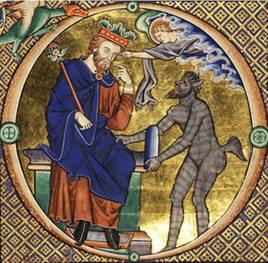
- Close with prayer: Remind the students of Nathan’s statement to David, “You are the man!” Allow each student, either silently or aloud, to share a cover-up they need to confess and be forgiven for. Pray for each other, or, even better, invite the priest to come to the end of class to hear confession.
Solomon
SOLOMON
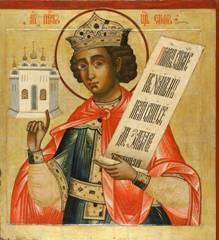 Possible Lesson Plan:
Possible Lesson Plan:
- Open with prayer.
- Scripture reference: 3 Kingdoms/ I Kings 1 & 3, II Chronicles 3-5, 9. Have these questions on the board or printed on sheets for each student to find the answers as he reads:
Who was Solomon’s mother? His father?
Who tried to steal Solomon’s throne before David was even dead?
What did the people shout when Solomon was anointed king?
What animal did Solomon ride to be anointed king?
Who was the prophet of David and Solomon?
How did God appear to Solomon?
What did Solomon ask for? Why?
What great achievement did God allow Solomon to accomplish?
What three books of the Bible did Solomon write?
What woman complicated Solomon’s last years?
Interestingly, the Queen of Sheba, took the child, son of Solomon and herself, back to Ethiopia, where he and his dynasty ruled in unbroken succession for thousands of years, until the last Emperor, Haile Selassie, in the late 1900s.
- Service References: The entrance of the ark into the Temple of Solomon in I Kings 7 is read at vespers of the Entry of the Theotokos as in matins we sing, “A child in the flesh but perfect in soul, the holy Ark enters into the house of God” and in matins “she is led today into the Holy of Holies, there to be brought up unto the Lord.” She is also called the Cherubic Throne – “the Virgin the throne of the cherubim” – at Christmas – a great mystery.
The veil of the Temple was placed between the people and the Holy of Holies, containing the ark. At the crucifixion “For by Thy lifting up today the Hebrew race perished. The veil of the temple was torn in two.” In what way did the Hebrew race perish with the crucifixion? How was that symbolized by the torn curtain?
- Discussion: In place of discussion today, we’re going to have good, plain fun. Bring lots of clay or play dough – air-hardening clay in large containers is available in craft or school supply stores. As the teens read the description of the Temple in II Chronicles 3-5, have them make an accurate replica of the temple from the clay. Next week, when it’s dry, spray the entire masterpiece gold for a lasting teaching tool for the younger classes.
- Close with prayer: Is there an area in the student’s life now where he or she needs wisdom? Pray now for the wisdom of Solomon.

Ecclesiastes
ECCLESIASTES
Possible Lesson Plan:
- Open with prayer.
- Scripture Reference: the book of Ecclesiastes. The younger classes have focused on Proverbs and Song of Songs; here we meet Solomon’s “other book”. “Ecclesiastes” means “the preacher”. This book delves into one of the most difficult questions of all: What is life all about anyway? It’s one of the toughest books of the Old Testament and seems very negative. Have each of the students read one (or more, if you have fewer students) of the following passages and decide whether it shows a positive, negative, or indifferent approach to life:
1:2-11 2:18-26 3:1-8 3:16-4:3 4:4-16
5:1-9 5:10-6:12 7:1-29 8:1-15 8:16-9:12
9:13-10:20 11:1-8 11:9-12:7
Cards to be copied and handed out are on the next page. After tallying the responses and summarizing the results, what view do you feel the author has toward life? What might be some reasons for this view? Read together Ecclesiastes 12: 8-14. What do you think of the author’s final conclusion? Do you know anyone who sees life like this author? What causes a person to view life this way?
- Discussion: Have the students consider the characters in Peanuts: bring a cartoon if you have one. How does Snoopy approach life? Charlie Brown? Lucy? Pick your favorite character; in what way are you most like that character? Share your responses. What’s the difference between an optimistic outlook and a pessimistic outlook? Which do you have most of the time?
When we adopt a cynical or pessimistic outlook, we can easily overlook God’s gifts. Make 4 columns on the board and brainstorm gifts for each column: Material (e.g., a car), Physical (e.g., good health, good looks), Emotional, Spiritual. Why do we sometimes forget about all these good things? Which of the 4 areas has been the easiest to find examples for? The hardest? Why? In what ways have you shown appreciation for these joys of life? In what ways could you?
Did you ever feel life was pointless? Did the author of Ecclesiastes? The philosophy of life that focuses on the lack of reason behind existence is known as “existentialism”. Does life have any meaning? Will we ever know the answer to that question? What gives life meaning?
4. Craft: Time for every purpose spinner. This is a very famous section from Ecclesiastes, turned into a folk song by Pete Seeger in the 1950s. Print the two pieces on cardstock, cut out, and use a brad to fasten the different times in one’s life behind the opening. Discuss times in the student’s life where these things have occurred. Are they building now, or tearing down? Sowing or reaping? Mourning or dancing? Loving or hating?
5. Close with prayer: Have the students offer a prayer of thanksgiving for ways they can see God in their lives and gifts He has given them.
|
1:2-11 |
2:18-26 |
3:1-8 |
|
3:16-4:3 |
4:4-16 |
5:1-9 |
|
5:10-6:12 |
7:1-29 |
8:1-15 |
|
8:16-9:12 |
9:13-10:20 |
11:1-8 |
|
11:9-12:7 |
12:8-14 |
12:8-14 |
|
12:8-14 |
12:8-14 |
12:8-14 |
|
12:8-14 |
12:8-14 |
12:8-14 |
|
12:8-14 |
12:8-14 |
12:8-14 |
Elijah
ELIJAH
Possible Lesson Plan:
- Open with prayer.
- Scripture Reference: 3 Kingdoms/I Kings 17-19, 22, 4 Kingdoms/II Kings 1-2. The prophet Elijah arose during the reign of the evil King Ahab and Queen Jezebel. The people of Israel turned to worship Baal, and Elijah had to stand up for God against formidable odds. But, later, Elijah ran from Jezebel’s anger. Have each student (or a group) read one chapter. Ask him or her to summarize the chapter with a single drawing on a sheet of paper. Have each student (or group) explain its drawing. What 2 miracles occurred in Zarephath? Why did Elijah go to speak to King Ahab? What was God’s curse on Israel? Why did Elijah destroy all the prophets of Baal after he won the challenge? Why did Elijah run from Jezebel? Was he cowardly? Why or why not? When Elijah was in the wilderness, why did he want to die? What made him willing to return and face Ahaziah, Ahab’s successor?
- History: We are entering a very confusing period in Jewish history and one with which few Christians have much acquaintance. Therefore, with each of the next several lessons, we will attempt to keep track of the kings, prophets, and events and see the interconnection between them. So far, we’ve seen the kingdoms of Saul, David, and Solomon. After the death of Solomon, the kingdom was divided – Israel in the north with its capital of Samaria under Jeroboam and Judah in the south with Jerusalem as its capital under Rehoboam. There followed in both kingdoms a series of mostly wicked kings, while in the rest of the world Assyria was rising to power. Finally we reach Ahab, king of Israel and the worst so far, while Judah was ruled by Jehoshaphat, one of the best ever. These were the times into which Elijah was born and during which he prophesied. I have included after this lesson a summary of the kings and prophets; use it frequently as a reference.
- Service References: The most striking reference to Elijah is at the feast of the Transfiguration, where he appears with Moses talking to Jesus (at vespers): “Talking with Christ, Moses and Elijah showed that He is Lord of both the living and the dead, the God who spake of old through the Law and the prophets.” And “Moses who saw God and Elijah who rode in the chariot of fire, passing across the heavens unconsumed, beheld Thee in the cloud at Thy Transfiguration…” The story of Elijah and the “still, small voice” is read at vespers of the Transfiguration. Why was Elijah chosen of all the prophets?
John the Baptist is in his synaxis called “a new Elijah, like him displaying before the world an immaterial life; and with boldness thou hast openly reproved the transgressions of the King and Queen.” Which king and queen for Elijah? For John? In what way was John like Elijah returned?
But several of Elijah’s other miracles are also the subject of the hymnographers. His flaming chariot gets mention at Pentecost: “Of old the fire-breathing, zealous Elijah did mount with joy the all-flaming chariot. Wherefore, this sign did explain the rising of the gentle breeze illuminating the Apostles from on High, through which they were lighted, making known to all the Trinity.” How was the chariot like the flames of Pentecost? The story of the resurrection of the widow’s son in I Kings 17 is read on Holy Saturday – a type of the Resurrection of the Lord. Elijah passed through the Jordan on dry land before his death, just as Moses passed through the Red Sea; this story from II Kings 2 is read at Theophany. Why? The story of Elijah and the prophets of Baal is read on Theophany at vespers, and at the blessing of the water at Theophany, God is referred to as “our God who by water and fire through Elijah hast brought back Israel from the error of Baal”. Why is this important?
- Discussion: Elijah stood up for what he believed, but he struggled with opposition. Have each student think of an issue that he feels strongly about – at school, at home, in the church, in the world. This could be something as personal as cheating in school or as far-reaching as abortion. Have the student write a “Letter to the Editor” of the paper discussing the reasons for his concern, potential consequences, and suggestions for improving the issue. Why is this issue so important to you? Are there other ways we can stand up for something we believe in? Can you write a letter from Elijah to Ahab’s newspaper?
Are there any times when you have stood up for what you believed in even when others were opposed? What happened? Are there consequences? Is there any occasion when you had strong feelings about something and remained silent? What happened?
- Close with prayer: Have each student identify something he has strong feelings about and pray for the courage to stand even when others are opposed.
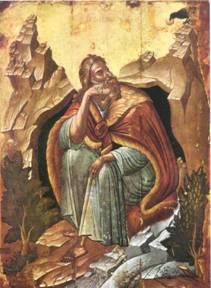
KINGS AND PROPHETS: A reference for this difficult time in Jewish history
DATES KING OF ISRAEL KING OF JUDAH PROPHETS OTHER KINGS
------------------------------------------------------------------------------------------------------------------------------
933 BC Death of Solomon and division into northern and southern Ahijah Shishak (Egypt)
kingdoms – concubines and idolatry
33 BC Jeroboam (22 years) – Bad Rehoboam (17 years) – bad Shemaiah
915 BC Abijah (3 years)–bad mostly
912 BC Asa (41 years) – good
911 BC Nadab (2 years) – bad
910 BC Baasha (24 years) – bad
900 BC Rise of Assyria to world power Assur-nasipal II
887 BC Elah (2 years) – bad
886 BC Zimri (7 days) – bad
886 BC Omri (12 years) – horrible
875 BC Ahab (22 years) – the worst Elijah Shalmaneser II
874 BC Jehoshaphat (25 yrs.)–good Ben-hadad (Syria)
855 BC Ahaziah (2 years) – bad Elijah Mesha (Moab)
854 BC Joram (12 years) – bad mostly Elisha Hazael (Syria)
850 BC Jehoram (8 years) – bad
843 BC Jehu (28 years) – bad mostly Ahaziah (1 year) – bad Elisha
843 BC Athaliah (6 years) – horrible
843 BC Joash (40 yrs.)-good mostly Joel
820 BC Jehoahaz (17 years)—bad
806 BC Joash (16 years) – bad
803 BC Amaziah (29yrs)–gd mostly
790 BC Jeroboam II (41 years)-bad Jonah
787 BC Uzziah (52 years) – good Amos
749 BC Jotham (16 years) – good Hosea
748 BC Zechariah (6months) – bad Isaiah
748 BC Shallum (1month) – bad Micah
748 BC Menahem (10 years) – bad
741 BC Ahaz (16 years) – wicked Rezin (Syria)
738 BC Pekahiah (2 years) – bad
748 BC Pekah (20 years) – bad Tilgath-pileser II
730 BC Hoshea (9 years) – bad
721 BC Northern Kingdom Fell. Sargon II
726 BC Hezekiah (29 years) – best Sennacherib
697 BC Manasseh (55 years) –worse Esar-Haddon
641 BC Amon (2 years) – the worst Assur-banipal
639 BC Josiah (31 years) – the best Zephaniah
608 BC Jehoahaz (3 months) – bad Nahum
608 BC Jehoiakim (11 yrs) –wicked Jeremiah Necha II (Egypt)
607 BC Fall of Assyria and Rise of Babylon Habakkuk Nabopolassar
597 BC Jehoiachin (3 months)–bad Nebuchadnezzar
597 BC Zedekiah (11 years) – bad Obadiah
586 BC Fall of Judah.
606-536 The Captivity Daniel Belshazzar
Ezekiel
536 BC Fall of Babylon and Rise of Persia Cyrus
536 BC Return from Captivity
Joshua Haggai
Zerubabbel Zechariah Darius I
485 BC Esther Xerxes I
457 BC Ezra Artaxerxes I
444 BC Nehemiah Malachi
Elisha (and more kings)
ELISHA AND MORE KINGS
Possible Lesson Plan:
- Open with prayer.
- Scripture Reference: II Chronicles 24-33. In the younger years, we have concentrated in this lesson on Elisha. But, here we will focus on a happier period in the history of Judah, the southern kingdom. Have the students read through the passage, listing each king, whether he was good or evil, and at least one prominent event from his reign (if there were any!). How does one decide about good vs. evil? Then play “King Concentration” with the names of the kings (two of each) in rows randomly on the board. For simplicity, cover each with a piece of Post-It paper with a number on it over each. The student who matches two and can say something about that king gets the points and keeps going.
- History: For over 100 years, from Joash to Jotham, Judah enjoyed prosperity under good kings. Then, after the corrupt reigns of Ahaz, Manasseh, and Amon, Hezekiah, a good and wise king, brought the people back to the Lord. Most importantly, he reinstituted temple worship, a cause of great celebration among the people. Meanwhile, the northern kingdom of Israel had fallen to Assyria.
- Service References: The story of Elijah and Elisha passing dry-shod through the Jordan is read at Theophany; “The river Jordan once turned back before the mantle of Elisha, after Elijah had been taken up into heaven, and the waters were divided on this side and on that: the stream became a dry path before him, forming a true figure of the baptism whereby we pass over the changeful course of life” and from matins “The prophet once disclosed the grace of baptism in the Holy Spirit, when he struck the streams of Jordan with his mantle. Its waters now are parted once again, for Christ has appeared in them and makes a path for us unto divine regeneration.” This time the water was not struck by a rod or an ark but by a mantle: “The stream of Jordan was formerly cut in two by a mantle, prefiguring Thy baptism whereby the robe of the passions is rent, and a garment of incorruption is woven for those who cry aloud: O Christ our God, blessed art Thou.” How is Elisha’s mantle our baptismal robe? The cleansing of Naaman in the Jordan from II Kings 5 is also read at vespers of Theophany. Why? And the story of the purification of the spring of Jericho with salt is read on Theophany also. Why?
References occur to other miracles of Elisha. His raising of the son of the Shunamite woman in II Kings 4 is read on Holy Saturday. What does it prefigure? And on the Exaltation of the Cross we sing at matins, “Jordan received into its deep bosom a sharp ax, and then was forced by a stick of wood to give it back again, thus betokening the cutting of error by the Cross and baptism” – such a tiny and seemingly insignificant miracle. How does this prefigure both feasts?
- Discussion: We’ve spent so much time on the kings and history, that there is little left for discussion. Let’s have some fun! Let’s celebrate with Hezekiah! Plan a “Hezekiah Party” for the younger children for next week’s opening exercises. What are we celebrating? How can we celebrate it? Be creative: a temple-shaped cake? A skit? Ram’s horns and menorahs? Balloons decorated how? A game? Remember, they do not know the story and may need to be told the meaning of the decorations, refreshments, and games.
Alternately, if you’re not into parties, think about politics. Ugh! What made a good leader for Judah? A bad one? A good leader today? A bad one? The Hebrews were stuck with their king, we vote for our leaders. Most of you will be voting soon. How do you decide whom to vote for? What qualities are you looking for? List our present and most recent past presidents on the board. Good qualities? Bad qualities? Which king of Judah would each of them most resemble and why? Once elected, is there anything we can do to improve their “reign”?
- Close with prayer: Pray for the leaders of our country.
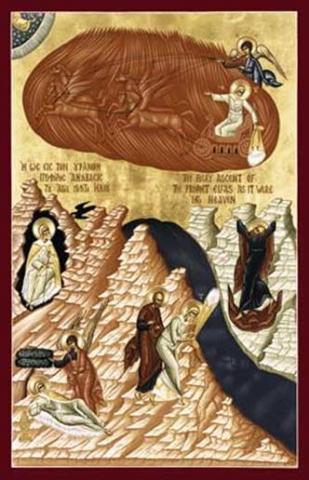
Jonah
JONAH
Possible Lesson Plan:
- Open with prayer.
- Scripture Reference: the book of Jonah. Have each group read a chapter. Summarize their findings as a newspaper headline. If you want to, you can bring in newspapers and they can cut out words and glue them into the headline. What point is God trying to make with Jonah?
- History: Jonah lived after Elijah and Elisha and before Isaiah. At the time, the northern kingdom of Israel was being threatened by Assyria. And where was he being told to go – to Ninevah, the capital of Assyria! The ultimate evil! Do you think he would expect a warm welcome in the capital of his country’s worst enemy? Did he have reason to be afraid? Did he have reason to hate the people he was asked to serve? How would you feel if you were asked to serve the biggest bully at school? Meanwhile, Judah, the southern kingdom, was enjoying prosperity under the good kings we studied last week.
- Service References: The story of Jonah in the belly of the whale has been identified as a type of the grave and resurrection of our Lord. The entire book of Jonah is read on Holy Saturday. At matins of the Nativity of the Theotokos, at matins of the Holy Cross, and again at the Transfiguration, we read, “Jonah stretched out his hands in the form of a cross within the belly of the sea monster, plainly prefiguring the redeeming Passion. Cast out from thence after three days, he foreshadowed the marvelous Resurrection of Christ our God…” The Paschal Canon states, “and like Jonah from the whale on the third day, Thou didst arise from the grave.” And the Canon of Holy Saturday matins states, “Jonah was enclosed but not held fast in the belly of the whale; for, serving as a figure of Thee, who hast suffered and wast buried in the tomb, he leapt forth from the monster as from a bridal chamber…” How did Jonah prefigure Jesus?
Jonah in the belly of the fish becomes Jesus in the womb of the Theotokos at matins of the Entry of theTheotokos: “The sea monster spat forth Jonah as it had received him, like a babe from the womb: while the Word, having dwelt in the Virgin and taken flesh, came forth from her yet kept her uncorrupt.” And at the Dormition, Jonah prefigures the 3 days burial of the Theotokos before her translation to heaven: “The fire within the whale, the monster dwelling in the salt waters of the sea, was a prefiguring of Thy three days’ burial, and Jonah acted as interpreter.” How did Jonah prefigure both the Nativity of Christ and the Dormition of the Virgin?
And, not to leave out poor Ninevah, on Cheesefare Sunday we pray, “Save us therefore as of old Thou didst save the people of Ninevah…” What was their response to the message of Jonah? St. Andrew of Crete, in his canon sung during the first week of Great Lent, advises us to follow their example: “Have you not heard how the Ninevites, moved by Jonah's preaching, repented in sackcloth and ashes? Why then have you not followed their example? For in its pride your heart is harder than all that have sinned both before and after the Law.”
- Discussion: Jonah disobeyed a direct order from God. A serious error? What were the consequences? What in our life is similar to Jonah’s experience? Likely we’ll never be asked to travel to Ninevah. But, we all “mess up”. What is mercy? Write a definition. Like Jonah in the belly of the fish, we feel isolated from God when we disobey Him. God’s mercy brings blessing when punishment is deserved. Is there any time this week when you experienced mercy? From a parent, a friend, a teacher, a fellow-driver? What did Jonah do to escape the belly of the fish? What can we do to escape the darkness of being shut off from God? Why does God often choose to show mercy even though we deserve punishment? Do we usually show mercy toward others, or do we like to see people get what they deserve? How can we begin to show more mercy toward others?
- Close with prayer: Have each student consider a situation where he or she usually shows judgment instead of mercy (for those who drive, consider inconsiderate driving habits or road rage). Pray for a change in attitude to one of mercy.
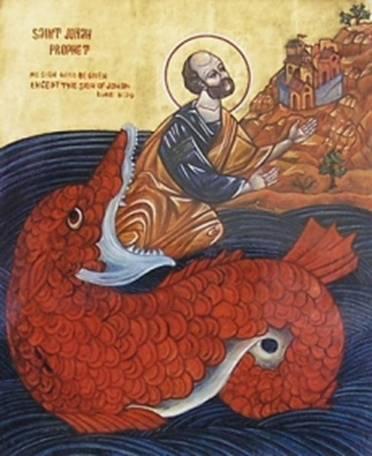
Isaiah
ISAIAH
Possible Lesson Plan:
- Open with prayer.
- Scripture Reference: Isaiah 1, 40-41. Have the students silently scan the reading. Then divide into 3 teams. Assign one chapter to each team. Instruct each team to write 5 questions for the other teams about its chapter. Write the answers on the board in three columns entitled “1”, “40”, and “41”. Play Jeopardy with 2 volunteer students if there’s time, or just write the questions.
What brought God’s judgment on His people? Why wouldn’t the people listen to Isaiah’s warnings? Why did God bother to reach out to His people?
- History: While Elijah and Elisha were prophets of Israel, the northern kingdom, Isaiah prophesied to Judah, the southern kingdom. He lived during the reigns of Ahaz and Hezekiah. He warned the people of Judah about the consequences of their actions. Judah didn’t listen, and Isaiah’s predictions came true. But, in the later chapters, God offers through Isaiah encouragement for Judah after the nation suffered the consequences of their actions and went into exile.
- Service References: The coal of Isaiah makes its way into many services. At Theophany: “The living coal that Isaiah foresaw is kindled in the waters of the Jordan, and He will burn up the whole substance of sin and grant restoration to the broken.” The vision itself from Isaiah 6 is read at the vespers of the Meeting of the Lord. The Theotokos becomes a pair of tongs: “Mary, thou art the mystic Tongs, who hast conceived in thy womb Christ the live Coal.” And “Christ the coal of fire, whom holy Isaiah foresaw, now rests in the arms of the Theotokos as in a pair of tongs, and He is given to the Elder.” Simeon answered, “Isaiah was cleansed by receiving the coal from the seraphim…Thou dost fill me with light as thou dost entrust to me, with thy hands as with tongs, Him whom thou holdest…” What is a tongs? How is Jesus a coal and Mary a Tongs?
Isaiah’s prophecies of Jesus are myriad. He prophesies the Virgin birth, the crucifixion, the resurrection, and the ascension. Chapter 52 is read on Holy Friday. The Paschal Canon recognizes the phenomenal nature of Isaiah’s prophecies in “Isaiah, as he watched by night, beheld the light that knows no evening, the light of Thy Theophany, O Christ that came to pass from tender love for us; and he cried aloud: ‘The dead shall arise and they that dwell in the tomb shall be raised up, and all those born on the earth shall rejoice exceedingly.’” And Isaiah 62-63 is read at Ascension: “Wherefore are his clothes red? Because he cometh from…the flesh.” Can you think of some other prophecies of Isaiah?
- Discussion: Ahead of class, make a group of traffic signs out of construction paper – Stop sign, Yield sign, One Way, No Parking, Speed Limit, etc. Hold these up and ask the teens what they mean and what could be the consequences of disobeying them. Do people always consider the consequences of their actions? Why not?
Now list on the board some tough situations involving obedience to God or parents that might face a teen (or have the class brainstorm these). You might include things like “I start using drugs”, “I cheat on a test”, “I have sex with my girl/boyfriend”, “I break the speed limit”, “I stop going to Church”, “I sneak out of the house to go to a bar”, “I start smoking”, “I talk behind someone’s back”, “I don’t study for a test”, etc. Make another column and list the likely consequences of these acts of disobedience.
What are the consequences of going against God’s will? Is it fair for every bad deed to have a bad consequence? What if we are sorry and never do it again? Does God sometimes let people “get by” without suffering the consequences? Is that fair? Can you think of a time when someone didn’t get what he or she deserved? What about yourself? How come some people don’t get “caught”? What about others who do wonderful deeds all their lives and never get any recognition? Is God fair? Or do people only seem to avoid the consequences of their actions?
- Close with prayer: Have each student consider one wrong action for which God has allowed them to go without facing the consequences. Repent of these actions and ask God to help us know His direction and make wise choices.
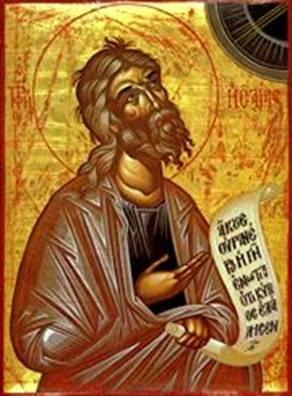
J
Jeremiah
JEREMIAH
Possible Lesson Plan:
- Open with prayer.
- Scripture Reference: Jeremiah 1, 13, 18, 20, 26, 38-39. A long and arduous book – difficult to pick out the “highlights”. Have one student read each assigned chapter and write it up in news format, presenting it to the class as a newscaster.
- History: Jeremiah was called after the fall of the northern kingdom, during the reign of the good king Josiah in Judah. Josiah took the throne at age 8 – the throne of a land already worshipping Assyrian gods and paying tribute to the king of Assyria, Ashurbanipal. With the advice of the high priest, Hilkiah, Josiah tore down the Assyrian gods and worship places throughout the land. Ashurbanipal died about this time, and Josiah was not punished for his insolence. Then, the book of the law was found and Josiah dedicated himself and his people to follow the Lord. But, with the death of Josiah, his reforms came to naught. His successors, Jehoahaz, Jehoiakim, and Jehoiachin, were all wicked. These, and the final king of Judah, Zedekiah, were the recipients of most of Jeremiah’s prophecy. But, did the kings listen to the words of the Lord? Instead, Jeremiah’s prophecies brought him ridicule and he was despised and finally imprisoned. Jeremiah, and his student Baruch, wrote down all that God had told him, but the king burned the scroll. They wrote the prophecies again for us to read. Jeremiah also wrote a letter, or epistle, and the book of Lamentations, lamenting the fate of Jerusalem at the hands of the Babylonians. During this time, the Babylonians sacked the temple and took captives; later they returned and leveled the city.
- Service references: The book of Jeremiah is read in several of the services but the references are a bit more obscure than Jonah or Isaiah. St. Andrew of Crete, in his canon read during the first week of Great Lent, uses Jeremiah directly as an example: “Thrown into a well, Jeremiah lamented bitterly the fall of Zion. Only by such a life of mourning and weeping, O my soul, will you find the way to salvation.” But, some of the historical references from the time of Jeremiah are quite interesting. Jeremiah lived through the fall of Jerusalem to Babylon; on Christmas we read, “The daughter of Babylon once led captive from Zion the children of David, whom she had taken with the sword: but now she sends her own children, the Magi bearing gifts, to entreat the Daughter of David in whom God came to dwell.” Who prefigured the Magi? And the prayer of Manasseh, King of Judah after Hezekiah and before Josiah in II Chronicles 33:12-13 is read during Great Lent and referred to in the prayers of Holy Unction and Confession. Why did Manasseh need to repent? What was the result of his repentance?
- Discussion: Jeremiah faced persecution throughout his career as a prophet. Persecution can be anything from someone giving you a dirty look to brutal murder. Who or what would you be willing to face persecution for? Poll the class for answers to these possible situations:Would you risk persecution for...
To protect a close friend? To turn down a drink?
To listen to certain music? To disagree with my peer group?
To abstain from sex? To stand up for what I believe?
To speak out on racial intolerance? To protect the rain forests?
Which are definitely worth facing persecution for and why? What in your life would you definitely fight to keep? What is the greatest rejection you ever faced in a relationship? What is the worst persecution you have ever faced at school? Can you remember a moment when you stood up for God? Is there a time when you should have stood up and be counted for your beliefs and didn’t? Why? What qualities do you see in Jeremiah you would like to have?
At many times in history (name some?) and in many countries even today (name some?) Christians are still persecuted, even to the point of imprisonment or martyrdom. Can faith be strengthened by persecution? Would you rather live in a time of heavy persecution? Why or why not?
- Close with prayer: Draw a cross on the board. Agree together to risk facing persecution for the Lord. Have each student sign the cross with a red marker.
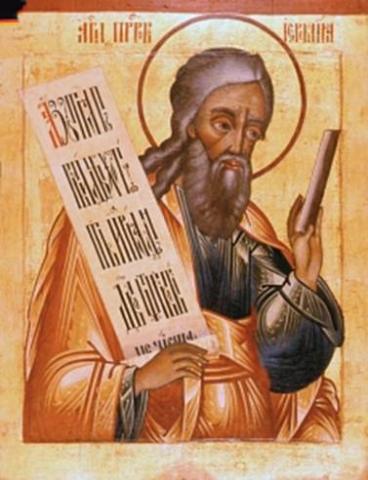
Ezekiel
EZEKIEL
Possible Lesson Plan:
- Open with prayer.
- Scripture Reference: Ezekiel 1, 3:1-6, 4, 17:1-12, 37. Ezekiel is a book full of visions. Have the students scan each of the assigned passages. Give each student a slip of paper with a passage on it and play “Pictionary” with each student in turn drawing a picture of the vision and the class guessing which vision it is.
- History: Ezekiel lived at the time of the fall of Judah and the Babylonian captivity. Unlike Jeremiah, Ezekiel was carried away a captive with Daniel and the three young men. Initially the temple of Solomon was left intact. Ezekiel continued calling the people to repent of their sinful ways. They didn’t and 10 years later the temple was destroyed and the city of Jerusalem wrecked.
- Service References: Ezekiel 37 is most prominently read in the Matins of Holy Saturday, commonly celebrated on Holy Friday evening. What do the dry bones prefigure? But the most regularly referenced prophecy of Ezekiel is that of the “Gateway” in Ezekiel 43-44, read in the vespers of Annunciation. In the vespers of the Nativity of the Theotokos, Mary “is the only gateway of the Only begotten Son of God, who passed through this gate, yet kept it closed.” Again, at her entry into the temple, “Having opened the gates of the temple of God, the Glorious Gate through which human thoughts cannot pass now urges us to enter with her and to delight in her divine marvels.” At Christmas, “He has newly appeared from the closed gate”. How is Mary a gate? To what? Finally, the prophecy of Ezekiel 36 with the pouring out of the Spirit to the Gentiles is read on Pentecost. Why?
Iconic References: In most Orthodox Churches there is a representation of Ezekiel 1: 10 – “As for the likeness of their faces, each had the face of a man; each of the four had the face of a lion on the right side, each of the four had the face of an ox on the left side, and each of the four had the face of an eagle.” We see here Jesus the man as God incarnate, Jesus the lion for His divinity, Jesus the calf for His sacrifice for our sins, and Jesus the eagle for His resurrection and ascension. And, traditionally, these are each associated with one of the Evangelists – the man for Matthew, the eagle for John, the bull for Luke, and the lion for Mark. So in our own church look again to see the huge ceiling icon and each of the writers of the gospels in the ceiling corner indicated by his symbol.
- Discussion: The most famous of these visions is the dry bones. How did Ezekiel use the image of the bones? Do you ever feel “dried up” like the bones in the desert? Discuss. How does God’s action on the dry bones apply to you? What does this story tell you about God?
Ezekiel lived in a very hard time for the Jewish people – a time of great disappointment and sadness. We, too, often live with disappointments and hurts. How did Ezekiel respond to his misfortune? Did he lose hope in the Lord, his people, the whole world? What does the vision of the dry bones tell you about hope?
- Have each student consider the most painful problem he or she is facing – a family problem, one with a friend, poor self-esteem, etc. – and write it down. How does it feel to actually write down the problem? Now, give your dry bones to God – talk to Him about the problem and turn it over to Him. Is it hard to give problems to God? Why or why not? It’s also hard to carry burdens alone. God didn’t raise a single body from the bones; He raised an army. So we are to share our burdens with each other. Share the problems (either out loud or by folding the papers and putting them together in the center of the circle). Is it hard to share our problems with others? Pray together for all the problems and continue to pray for each other throughout the week.
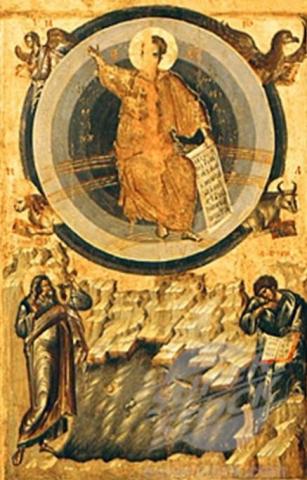
S
Shadrach, Meshach, and Abednego
SHADRACH, MESHACH, AND ABEDNEGO
Possible Lesson Plan:
- Open with prayer.
- Scripture Reference: Daniel 3. A short story, probably well-known to most of the class. In preparation for our craft today (Yes, even teens occasionally like crafts!), have each student write a short children’s version of the story, with as much speaking of the characters and as little by the narrator as possible.
- History: When King Nebuchadnezzar besieged Jerusalem during the reign of Jehoiakim, he took back with him captives from the nobles and royal family. These included Daniel, whom he named Belteshazzar, and Hananiah (renamed Shadrach), Mishael (renamed Meshach), and Azariah (renamed Abednego). They were brought to his house and given tutors for education and rich foods. But, they were also to be taught to worship the gods of Babylon…
- Service References: In almost every major feast, the song of the Three Youths in the Fire is sung. Their faith is exemplary: “The furnace of the Chaldeans, flaming with fire, was bedewed by the presence of the Spirit of God, and the Children sang aloud: ‘O God of our fathers, blessed art thou.’” The furnace becomes the Theotokos, “For this image delivered them from the fire, and they walked in the midst of it unconsumed.” The 3 youths symbolize the Trinity at the exaltation of the Cross: “O ye Children, equal in number to the Trinity…” At Christmas, the Virgin proclaims the unusual nature of the furnace: “In Babylon of old by the command of God, the fiery furnace worked in contrary ways: burning the Chaldeans, it refreshed the faithful as they sang…The blameless Lady was amazed at the height of the mystery…and she said: ‘The heavenly throne is consumed in flames as it holds Thee: how is it, then, that I carry Thee, my Son?’” and in the canon “The furnace moist with dew was the image and figure of a wonder past nature. For it burnt not the Children whom it had received, even as the fire of the Godhead consumed not the Virgin’s womb.” What mystery? On Theophany “The Babylonian furnace, as it poured forth dew, foreshadowed a marvelous mystery: how the Jordan should receive in its streams the immaterial fire, and should encompass the Creator, when He was baptized in the flesh.” What’s the mystery here? In the passion gospels, “The godly youths exposed a monument of godless wickedness, but the lawless assembly is enraged and takes vain counsel against Christ.” What monument? What assembly? On Holy Saturday the entire story is read. And in the Paschal canon, “He who saved the three young men in the furnace became incarnate and suffered as a mortal man. Through His sufferings He clothed what is mortal in the robe of immortality.” And, on Pentecost, the fire is again referenced. Why?
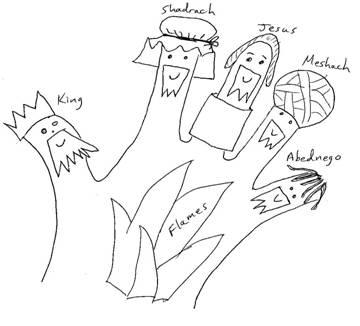
- Craft: In lieu of discussion, we’ll try a craft today. Each student should have a white or tan gardening glove, some scraps of fabric, lace, felt, ribbon, yarn. Turn each finger of the glove into one of the characters and on the palm, felt or fabric paint flames. The students can use the story glove to tell this wonderful story to smaller children while babysitting, at church, etc. Practice telling the story to each other, using different voices for the characters.
- Close with prayer: Pray for the courage to stand up for our beliefs as the three youths did for theirs
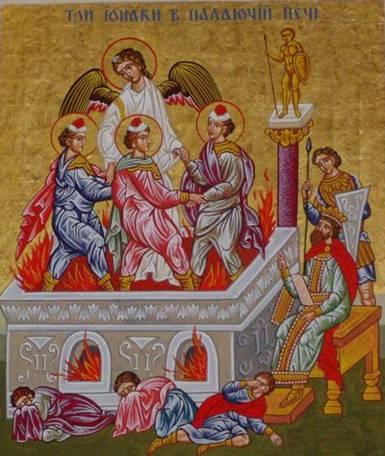
Tobit
TOBIT
Possible Lesson Plan:
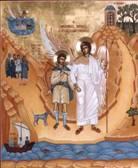 Open with prayer.
Open with prayer.
- Read the story of Tobit: Have each student read 1 or 2 chapters; there are 14 chapters in the book of Tobit. The story itself is quite an adventure – have the students act it out if they are so-inclined. Main characters could be Tobit, Tobias, the angel Raphael, Sarah and her father, Raguel.
- Discussion: What is the Apocrypha? (books contained in the Greek version of the Old Testament, known as the Septuagint, but not in the Hebrew. Why do some Christians include it in their Bible and some do not? Do we include these books in the Bible? Check your Orthodox Study Bible. Where are they? Where is the book of Tobit?
- Historically, the story of Tobit occurs during the days of the Assyrians, and Tobit lives in Ninevah. What does he recommend to Tobias in the last chapter? Which prophet prophesied the destruction of Ninevah? (Jonah)
- The church fathers view the book of Tobit as a type of God’s relationship with man throughout history. How does God work in the lives of Tobit and of Tobias? What means does God use?
- Tobit is a charitable man, and also a wise one. Read the 4th chapter very carefully. What counsel does Tobit give Tobias, knowing he may never see him again? What counsel would you give your best friend as he or she was about to leave for college or for a foreign country. Make a list of the most important pieces of advice you could give.
- Close with prayer. Pray a special prayer to live this week by the wisest piece of advice you've chosen for your best friend.
Daniel
DANIEL
Possible Lesson Plan:
- Open with prayer.
- Scripture Reference: Daniel 1,2,4,5, and 6. Most of the stories here of Daniel and his friends should be familiar, none more so than that of the lion’s den. After skimming the chapters, divide the students into 2 teams for a Bible Bowl. A team gets a point for each right answer. If they answer correctly, the team gets another question. If they answer wrong, the other team gets a turn with the same question.
What was the name of the first king Daniel and his friends served?
What were the names of Daniel’s three friends in Hebrew?
What honor did the king give to Daniel and his friends?
What did the king’s first dream mean?
What was the end of Nebuchadnezzar?
Who was the second king Daniel served?
Was he good or evil?
What miracle did this king see?
Who was the third king Daniel served?
What did the king do to punish his wicked counselors?
- History: Daniel lived through one of the most exciting periods in the history of Mesopotamia. Babylon, under Nebuchadnezzar, rose to its greatest prominence; its Hanging Gardens were one of the wonders of the ancient world. But, under Belshazzar, his successor, Babylon was conquered by Cyrus of Persia, who marched into the city with his army in the dead of night on the dry bed of the Euphrates River that flowed under the city walls (after damming the river!). Cyrus was succeeded by Darius, known to all students of Greek history as the Persian king who lost the battle of Marathon outside Athens. It was after this famous battle that the runner, Pheidippides ran 26 miles to Athens to gasp out the news that they had won and died. And to this day, 26 miles is the distance run in a “marathon”.
- Service References: Actually, the lions’ den gets few mentions, although there are many references to lions. Which prophecy of Daniel is heavily quoted? Daniel 2:45, read on Christmas. “For a young babe, even the Word, has now come forth from the Mountain that is the Virgin, Unto the renewal of the peoples.” And at the Annunciation, “Hail, uncut mountain!” Who is the mountain? Who the rock? How does this prefigure Mary and Jesus?
- Discussion: Daniel sat on the “hot seat” of life many times. What are some of the trials Daniel faced? What would you have done in Daniel’s place? What kind of trials are you going through? Have each student in turn take a center chair in the group and discuss one time when he or she was on the “hot seat” (for example, I feel like I’m on the hot seat when…). Then turn it around: “I put others on the hot seat when I…” (e.g., drive too fast). We all go through “lion’s den” experiences. How do we try to protect ourselves from trials? Which of these three groups – parents, teachers, or friends – throws you to the lions the most? Explain. Is there a reason for trials like this? Who is with us through the trials?
- Close with prayer: Have each student think of the lion’s den experience that most worries him. Pray for each other today and through the week.
Icon of Daniel
In the lion’s den.
Note the prophet
Habakkuk with the
Angel bringing food.
Esther
ESTHER
Possible Lesson Plan:
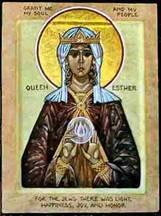 Open with prayer.
Open with prayer.- Scripture Reference: the book of Esther. The bones of the story should be familiar to the students. Assign roles ahead of time to the students: Esther, Ahasuerus, Haman, Mordecai, and Vashti. Have each scan the book with particular reference to his or her role. Then engage in an impromptu “reader’s play” where the only action is in the voices and facial expressions and act out the story. Have the rest of the students “boo” when Haman speaks,as in the Jewish festival of Purim.
- History: Ahasuerus is the Hebrew rendition of Xerxes I, king of Persia. Xerxes should also be familiar to the students from Greek history, as the king who crossed the Hellespont with an immense army on a bridge of boats and marched through the pass of Thermopylae, where he was met by the 100 Spartans of Leonidas. Although the Spartans were eventually defeated through the actions of a traitor, the Athenians had time to remove the entire population to a fleet of boats in the Bay of Salamis. When the larger Persian ships met the smaller, more maneuverable Athenians, the Athenians defeated the fleet of Xerxes (sound like the Spanish Armada some 2000 years later?), and he fled back to Persia, never to try again. Thus began the Golden Age of Greece.
- Discussion: There are many ways of pressuring others into what you want of them: How did Haman pressure the king? (lies and deceit) Mordecai Esther? (the “guilt trip”) Esther the king? (the sweet-talking wheedle?) What other methods might you have tried if you’d been Esther?
Every day someone’s trying to pressure us one way or another. Name some ways: TV ads, peer group, sales people, parents, fear of punishment, promised reward,… Have teens brainstorm and list on the board. Which one pressures you the most? Are you easily pressured? Was Ahasuerus? Esther? To get ahead in life, do you have to fit in with the crowd? How effective are you at persuading others? Do you tend to give in to people who continually pester you to do something you don’t want to do? Esther? Does sweet talk help to loosen people up when you want them to do something? If you’re right, is it OK to use a little deceit to persuade people to your side? (Esther and Ahasuerus?) Or send them on a “guilt trip” when they don’t want to do what you want? (Mordecai to Esther?)
Can Christians use pressure to Christ’s advantage? Is it right? Like Esther inviting Ahasuerus to dinner, how can we effectually invite others to Christ, to church? Can peer pressure help us do the right thing? Why is it sometimes difficult to make wise decisions when with non-Christian friends? What can we do to prepare for times when friends pressure us to do wrong?
- Close with prayer: Let’s try some positive pressuring this week: each student figure out a way to invite someone to church and Sunday School next week.
Minor Prophets -- Overview
MINOR PROPHETS: OVERVIEW
Possible Lesson Plan:
- Open with prayer.
- Scripture Reference: Okay, how would you like to go down in Biblical history as a “minor” prophet? Not only that, but no one has any idea who you were as a person or what you said and did! Like 12-tuplets… Not any more. Let’s meet each one -- maybe not in the depth we met Jonah, but at least a passing acquaintance. Have each student scan one or two books for a few minutes; they’re all short. Then summarize each in one or two sentences, trying to catch the essence of what the prophet said. Remember that Samaria was the capital of Israel, the northern kingdom, and Jerusalem of Judah in the south.
3. History: The setting and time are important here; give this information just before the student summarizes the message.
- Hosea: A prophet of the northern kingdom, after Elijah, Elisha, and Amos, speaking of Israel’s unfaithfulness to God in worshipping Baal
- Joel: An early prophet of Judah, just after the time of Elisha in the north, during the reign of Joash, before Isaiah.
- Amos: A prophet of Judah but speaking to Israel, knowing both Joel and Hosea, a shepherd with little education
- Obadiah: Obadiah lived in the time of the fall of Judah under Zedekiah but spoke to the Edomites, descendants of Esau and living in the mountains, always bitter enemies of the Jews. True to his prophecy, in 582 BC Edom was destroyed by the Babylonians
- Micah: Micah lived near Jerusalem, a contemporary of Isaiah
- Nahum: Capernaum was named for Nahum (“village of Nahum”). He is the second prophet to the Assyrians (Who was first?) and spoke after the fall of Israel to Assyria, but before the fall of Assyria to Babylon
- Habakkuk: Prophet of Judah, just after the wonderful reforms of Josiah, under the wicked king Jehoiakim, contemporary of Jeremiah. The matins of Holy Saturday say, “Foreseeing Thy divine self-emptying upon the Cross, Habakkuk cried out marveling: ‘Thou has cut short the strength of the powerful, O gracious and almighty Lord, and preached to those in hell.’” “The inspired prophet Habakkuk now stands with us in holy vigil. He is like a shining angel who cries with a piercing voice, Today salvation has come to the world…” states the Paschal canon. Habakkuk was also translated by the holy archangel to bring food to the Prophet Daniel in the lion’s den – a trip from Judah to Babylon in the wink of an eye.
- Zephaniah: Prophet of Judah during the reign of Josiah; he was a prime mover in the reformations of Josiah,& a prince,great-great-grandson of Hezekiah. He’s read on Palm Sunday because of his prophecy about the colt (3:14).
- Haggai and Zechariah: These men worked side by side preaching and teaching while the temple was being rebuilt just before Ezra arrived in Jerusalem. Haggai was an old man, while Zechariah was a young man. Zechariah 11 is read on Good Friday (30 pieces of silver) and 14 on Ascension.
- Malachi: Lived in the time of Nehemiah, when the Jews were back home from captivity, but apathetic and lax. Jesus is “the sun of Righteousness”
Confused? Try making a "Prophet Catcher":
Prophet Catcher
- With the printed side up, fold the square in half horizontally and then vertically, open the folds.
- Turn the square over.
- Fold each corner over so they meet in the middle, do not let them overlap.
- Leave the square folded, and flip the square over.
- Now fold the corners into the center – make sure they do not overlap.
- Fold the entire square in half and poke your thumbs and forefingers in under the flaps.
- Bring your fingers together so the Fortune Teller forms a peak –
- YOU are ready to PLAY!
Amos, the shepherd, Habakkuk with his pot of stew for the Prophet Daniel, Micah and his prophecy of the city of Bethlehem, and Haggai with the rebuilding of the temple in Jerusalem are on the 4 outside flaps. Can the students correctly identify the prophets associated with the quotes beside the numbers?
4. Discussion: Today we will focus on learning the immense amount of material above. Try “Final Jeopardy”: you give a clue, the students each write an answer on a small pad of paper and hold it up, each correct answer gets a point. You’ll have time for lots of questions and be able to see how much was absorbed.
5. Close with prayer: Have each student select a prophet who has “spoken” to him today and pray to be more like that prophet, heed his message, etc.
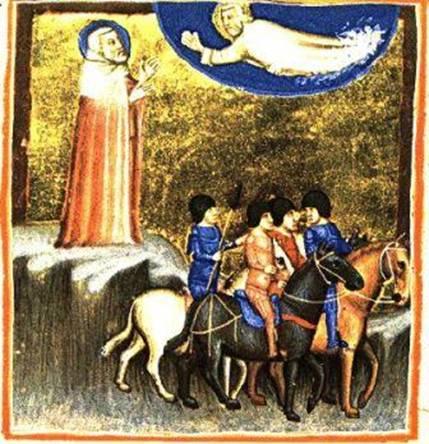 Icon of the prophet Habakkuk
Icon of the prophet Habakkuk
Minor Prophets -- Micah
MICAH
Possible Lesson Plan:
- Open with prayer.
- Scripture Reference: the book of Micah. Assign one chapter to each student. Have each seek an answer to these questions: What complaints does God have against the people? What is God planning to do? What image is painted of the future? Then share Micah’s vision with each other. What bothered Micah the most? Does our society commit any of the sins Micah described? Which? How?
- Service References: Micah 4:6-5:4 is read on the feast of the Nativity of Christ – “but thou, Bethlehem…” How did Jesus come to be born in Bethlehem, in fulfillment of this prophecy?
- Discussion: Read aloud Micah 6:8, a famous passage. Which is hardest for you: justice, kindness (mercy), or humility? Why? Before class, put several objects in a paper bag (e.g., soda, balloon, pencil, soap, McDonald’s wrapper, apple, comic strip, etc. – one for each student) Have the students each reach into the bag and remove an item. How could this item be used in an act of kindness to someone? Discuss. What’s the kindest thing someone did for you last week? You did for someone else? How do you feel when you receive a kindness? Why is it sometimes hard to show kindness? Who can you show kindness to most easily? How would life be different if we eliminated all acts of kindness?
5. Review of Old Testament characters: Old Testament Bingo
6. Close with prayer: Have each teen select an act of kindness that they could do in the following week with the object they received and follow through.
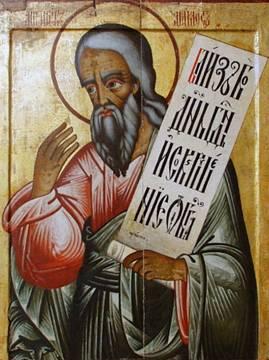
Ezra and Nehemiah
EZRA AND NEHEMIAH
Possible Lesson Plan:
- Open with prayer.
- Scripture Reference: the books of Ezra and Nehemiah. Divide into 2 teams: the Ezra team should scan chapters 1, 2, 3, 6, and 10 for the answers to the following questions:
What was Cyrus’s edict?
What did Cyrus give the Jews?
How many people returned?
What was the first thing they did?
When did work on the temple begin? When finished?
What difficult reform did Ezra carry out?
The Nehemiah team should scan chapters 1-5 for these questions:
What news was brought to Nehemiah? What does Nehemiah request?
What does he want to do in Jerusalem? What success does he have?
How does Nehemiah face the opposition?
What does Nehemiah do about wealth and poverty?
How does Nehemiah serve as an example to the people?
Review briefly the prophecies of Haggai and Zechariah, both contemporaries of Ezra. Have the whole class tackle these difficult questions: How do you think the Jews felt as they returned home? If you’d been a Hebrew with a foreign wife, would you have been willing to give her up? Why or why not? Why was it so critical to return to the law of Moses?
- History: After he captured Babylon, Cyrus of Persia allowed many of the Jews to go home under Zerubbabel. They began work on the temple, but the work was stopped by their enemy neighbors and nothing further was done for 15 years. Haggai begins to preach and Darius ascends the Persian throne. Work resumes on the temple, Zechariah continues Haggai’s mission, and Ezra is sent from Persia to re-institute the law and handle certain reforms. Many years later, Nehemiah returns and rebuilds the wall. Malachi preached in the days of Nehemiah.
- Discussion: All of us face times of starting over from scratch as did the Jewish people returning to their land after 70 years in captivity. It is a distressing and stressful time. Discuss the relative difficulty of these various starting-over times and why – Which would be worst? How could you cope?
You break up with your boy/girlfriend after a year.
Your parents divorce.
You move to a new city.
You fail a required course and have to take it over.
Your house burns down and you lose everything you own.
Your family dies in a car accident and you’re left alone.
You are permanently blinded in a car accident.
Why is it so hard to face starting over times? What’s the most difficult starting-over time you’ve experienced? How did you deal with it? Who helped?
- Close with prayer: Who do you know who’s facing a re-building time? How could you help? Pray together to follow through and help that person.
Apocrypha
APOCRYPHA: OVERVIEW
Possible Lesson Plan:
- Open with prayer.
- Scripture Reference: the books of the Apocrypha. These are books contained in the Septuagint, the Greek translation of the Old Testament, but not in the Hebrew version. Some are parallel versions or additions to existing books; others tell of events between the days of Nehemiah and the birth of Christ. Assign a book or two to each student to scan, present his or her summary and a comparison with the already-studied history and Scripture: does it fit in and where? These are included in the Orthodox Study Bible.
- History: These are very different books, with very different settings:
- I Esdras: Parallel version of the events in Chronicles/Ezra/Nehemiah.
- II Esdras: Also known as the Apocalpse of Ezra, a collection of visions interpreted by the angel Uriel about Jerusalem, Rome, and the Messiah.
- Tobit: Short story of a pious Jew in the days of the northern captivity.
- Judith: The story of a courageous young Jewish widow’s beheading Nebuchadnezzar’s general, leading to the retreat of the army.
- Additions to Daniel: Includes the Prayer of Azariah, the Song of the Three
- Holy Children, Susanna, and Bel and the Dragon.
- Additions to Esther: Just as it says, a longer version with more detail.
- Prayer of Manasses: Used in some of the Odes, mentioned in 2 Chr.33:11-19.
- Epistle of Jeremiah: A letter from Jeremiah to the exiles in Babylon.
- Baruch: A friend and scribe of Jeremiah addresses the exiles and laments.
- Ecclesiasticus: The wisdom of the scribe Joshua ben-Sira, who lived in Jerusalem around 180 BC, advice for life and the ideal of a scribe.
- Wisdom of Solomon: An exhortation to seek wisdom, likely written in the Alexandrian period and written originally in Greek.
- Wisdom of Sirach: Also a book of wise sayings.
- Maccabees: The story of Hanukkah and the pogroms under Ptolemy of Egypt.
- Discussion: Again, most of this material will be new and should be learned today. Maybe try a game of Concentration, but to win, the teens must not only match the books but say at least one thing about each.
- Close with prayer: Have each student select a book to read carefully this week in his prayer time. May the book speak to him from the Lord.
MACCABEES/HANUKKAH
Possible Lesson Plan:
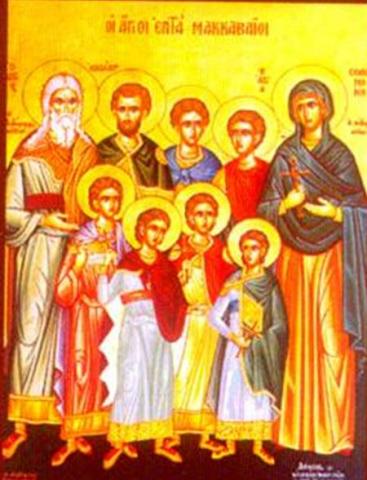 For this week, the best idea would be to get a Jewish speaker. The 10-12 class and middle school class could join you. Have a celebration as it is typically done and discuss the customs and their significance. You could also discuss the celebration of Purim, Passover, and the other Jewish feasts while you have the speaker.
For this week, the best idea would be to get a Jewish speaker. The 10-12 class and middle school class could join you. Have a celebration as it is typically done and discuss the customs and their significance. You could also discuss the celebration of Purim, Passover, and the other Jewish feasts while you have the speaker.
No speaker? Then try this lesson plan:
Possible Lesson Plan:
- Open with prayer.
- Tell the story of Judah Maccabee and his brothers:Tell the story of Judah Maccabee and Hanukkah: About 2200 years ago, Greek kings, who reigned from Damascus, ruled over the land of Judea and the Jews living there. One Greco-Syrian King, Antiochus Epiphanes, forbade the Jewish people from praying to their God, practicing their customs, and studying their Torah. Antiochus forced the Jews to worship the Greek gods. It is said that he placed an idol of the Greek God Zeus on the alter in the Holy Temple of Jerusalem. In response to this persecution, Judah Maccabee and his four brothers organized a group of resistance fighters known as the Maccabees. They fought against paganism and oppression. Against great odds, after three years of fighting, the Maccabees succeeded to drive the Greco-Syrians out of Judea. Hanukkah proclaims the message of the prophet Zachariah: "Not by might, not by power, but by My spirit." The Maccabees reclaimed the Holy Temple in Jerusalem. They cleaned the Temple, removing the Greek symbols and statues. When Judah and his followers finished cleaning the temple, they rededicated it. According to tradition, when the Maccabees entered the Holy Temple, they discovered that the Greco-Syrians had defiled the oil which was used to Temple's menorah. Only one vat of purified oil remained - enough for only one day. It would take the Jews a week to process more purified oil. Then a miracle occurred. The Maccabees lit the menorah and it burned for not one, but eight days, by which time the new, purified oil was ready. This is why the Hanukkah Menorah has eight candles (not including the shamash candle used to light the others) and one reason why Jews celebrate Hanukkah for eight days.
- Play with a dreidl: You can get one of these from Pat or at any store. Each letter has a meaning. Each child starts with about 20 raisins. Each puts one raisin in the center of the table. They take turns spinning the dreidl. If it lands on Nun, they get nothing. If it lands on Shin, they have to give a raisin to each player. If it lands on Heh, they get half of the raisins in the center. And if it lands on Gimel, they get all the raisins in the center. When you decide time is up, the child with the most raisins is the winner, and each gets to eat his raisins.
- Discussion: Hanukkah is celebrated in late December and is often referred to as the “Jewish Christmas”. Does Hanukkah have anything to do with the birth of Jesus? Whose story is told? We left Jewish history with the return from Babylon under the Persians. But the Persians were ousted by the Greeks under the Macedonian king Alexander the Great. Alexander’s empire collapsed with his death, but the Greek influence continued in Palestine under a whole dynasty of kings, all with the same name! What was it? (Antiochus). Antiochus I Soter was the son of Seleucus, the general of Alexander the Great who took control of most of Asia. It was Antiochus IV with whom the Maccabees had problems. What miracle occurred? How many days did the lamp in the great menorah burn? Why are there nine candles on the Hanukkah menorah? (one to light the others with)
- Close with prayer. Pray that we may recognize the miracles in our lives, just like the miracle of the menorah.
